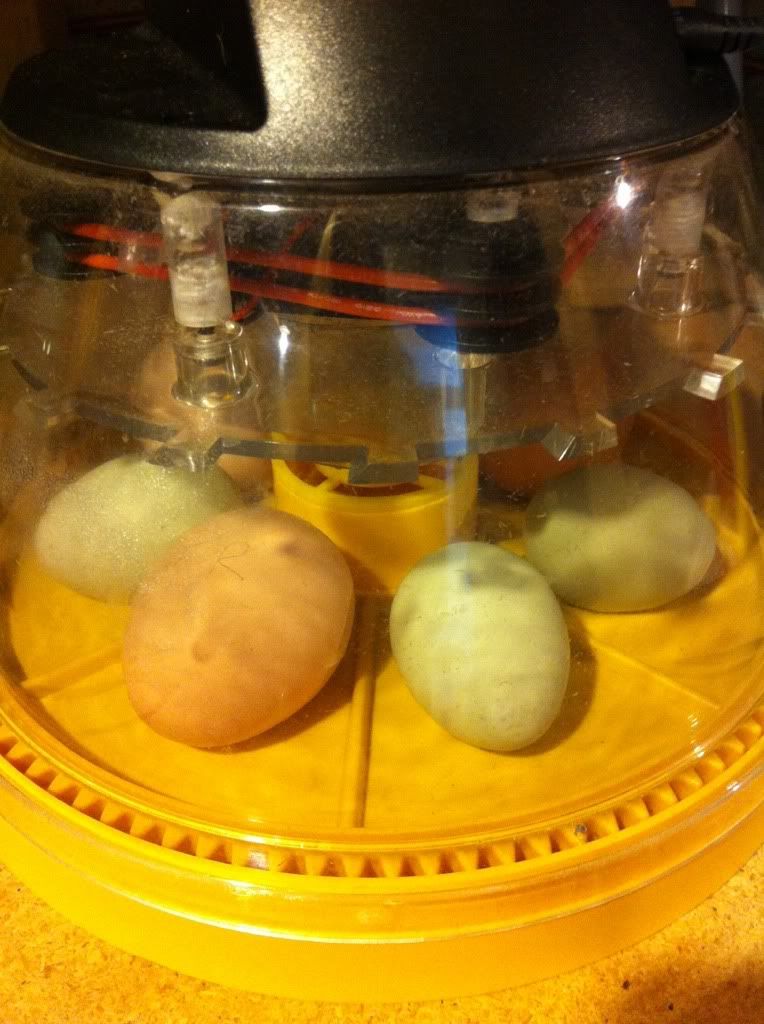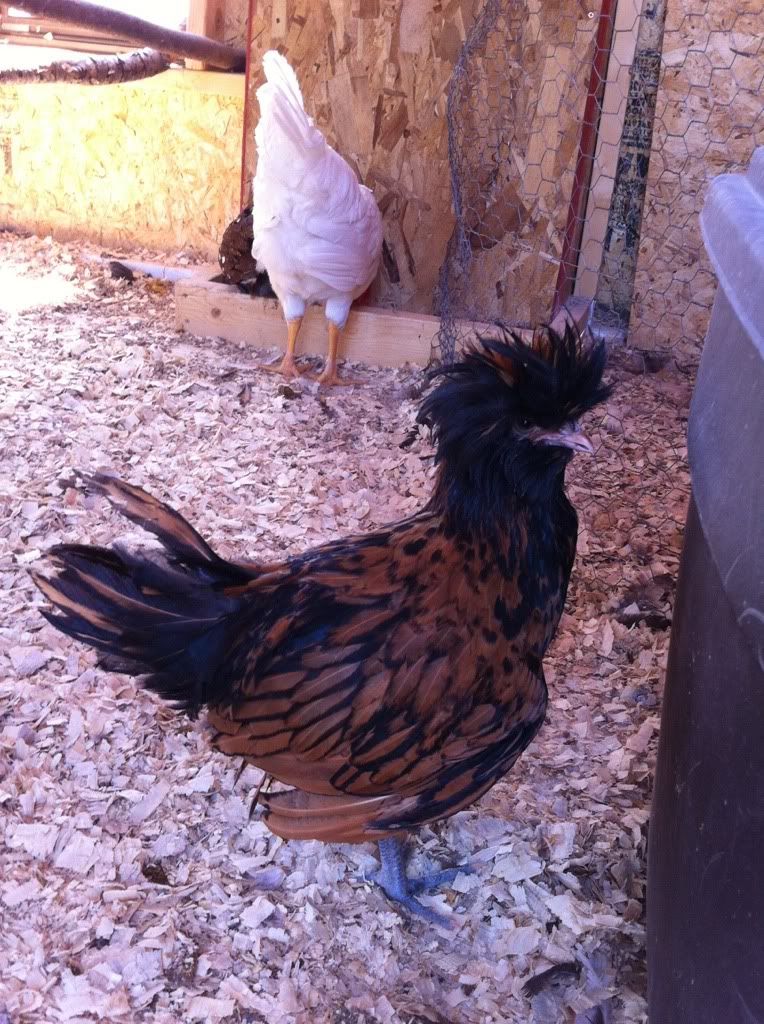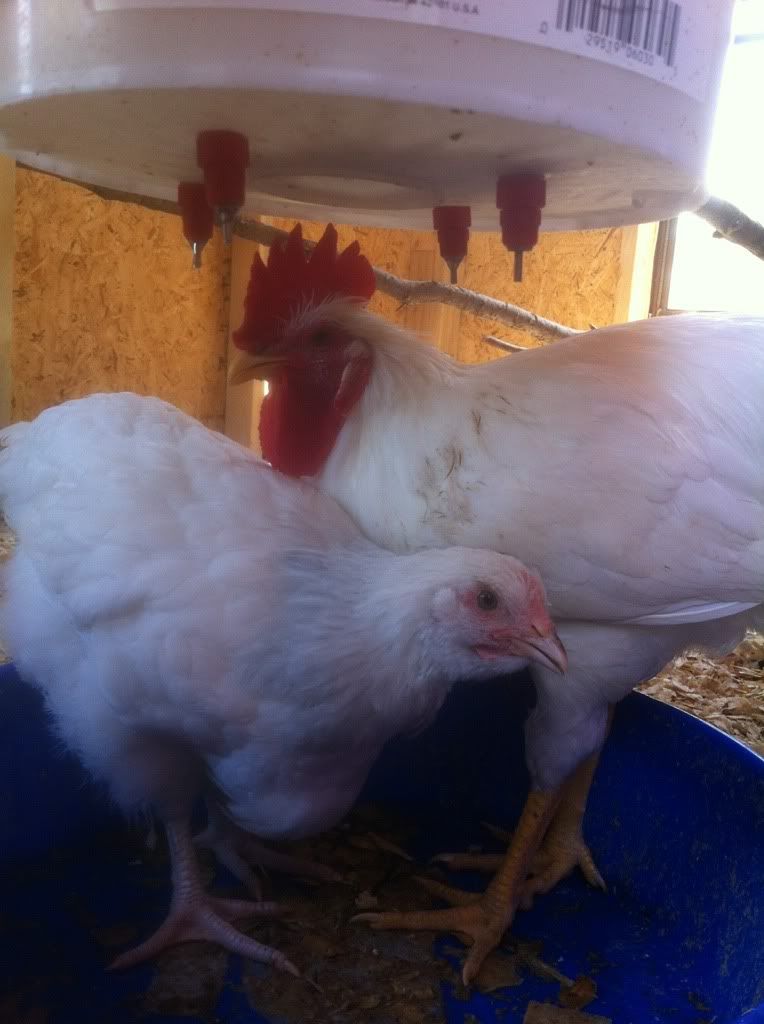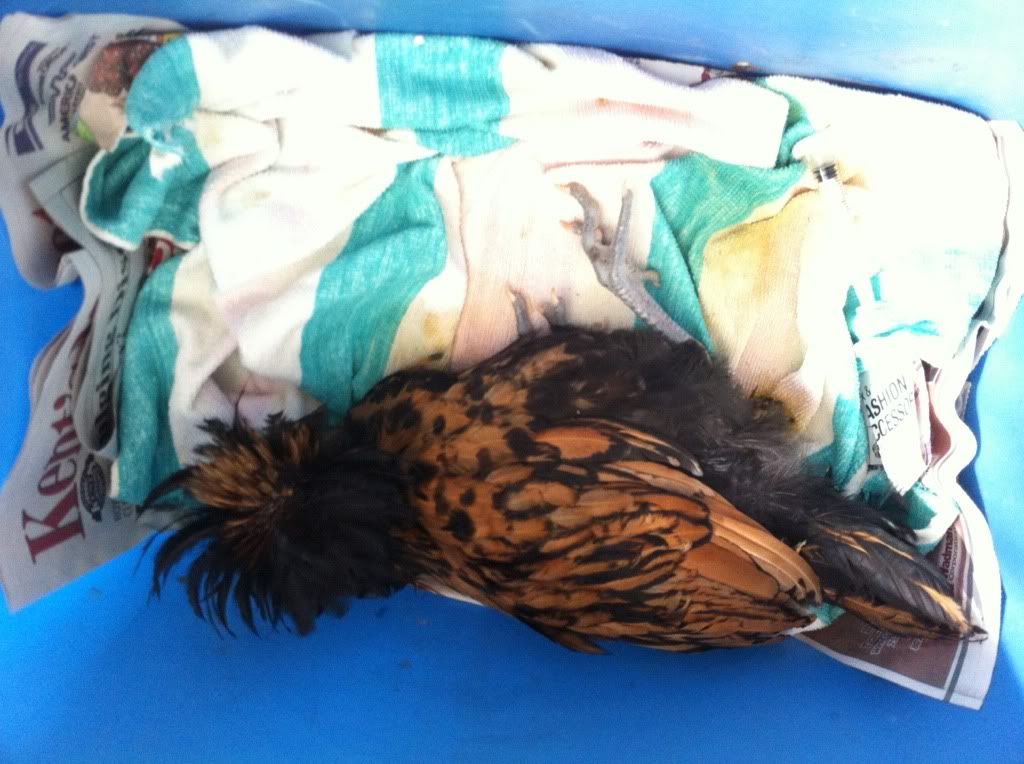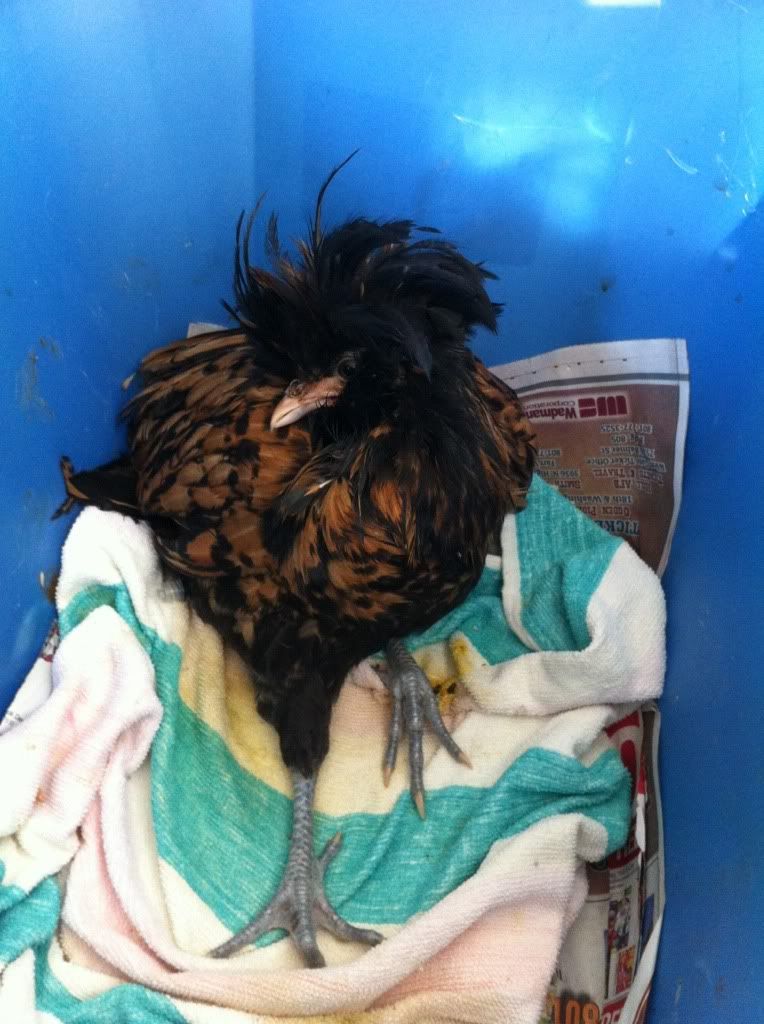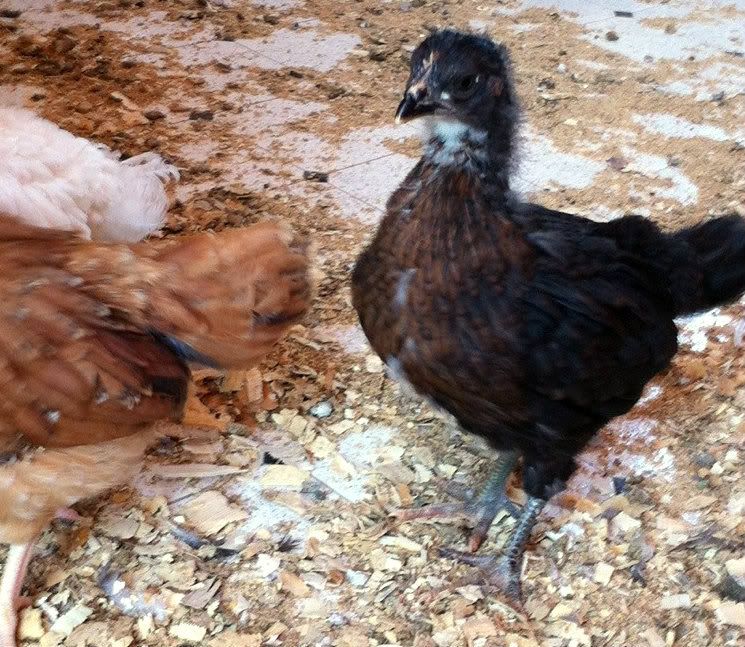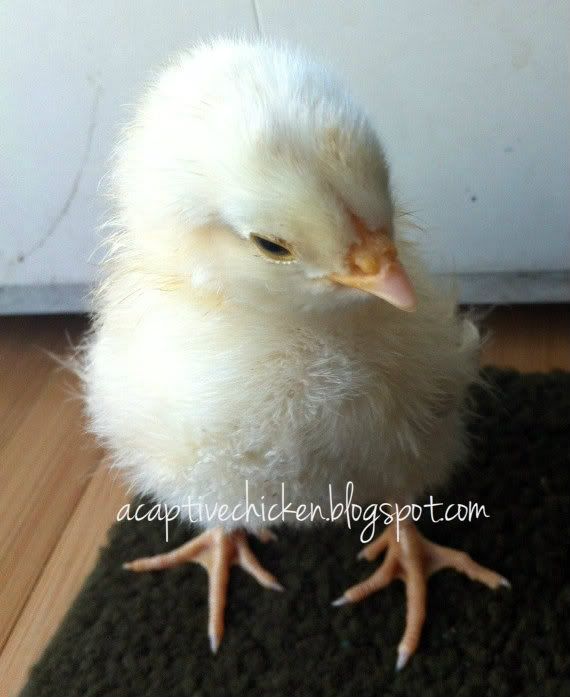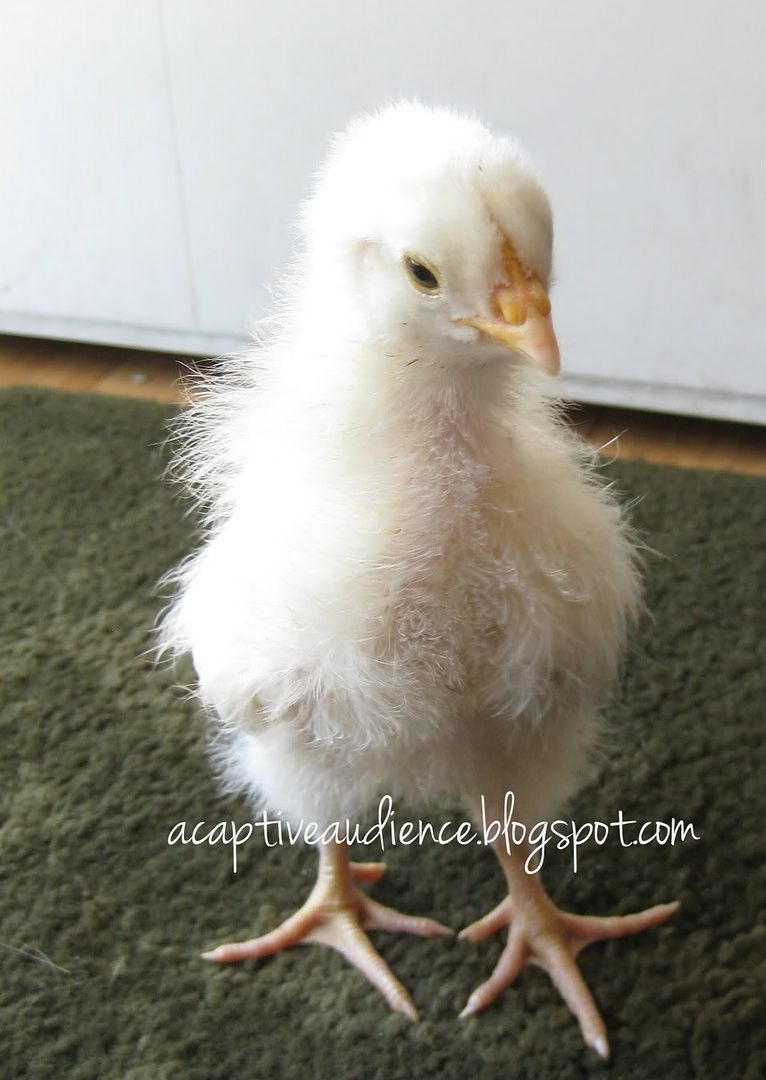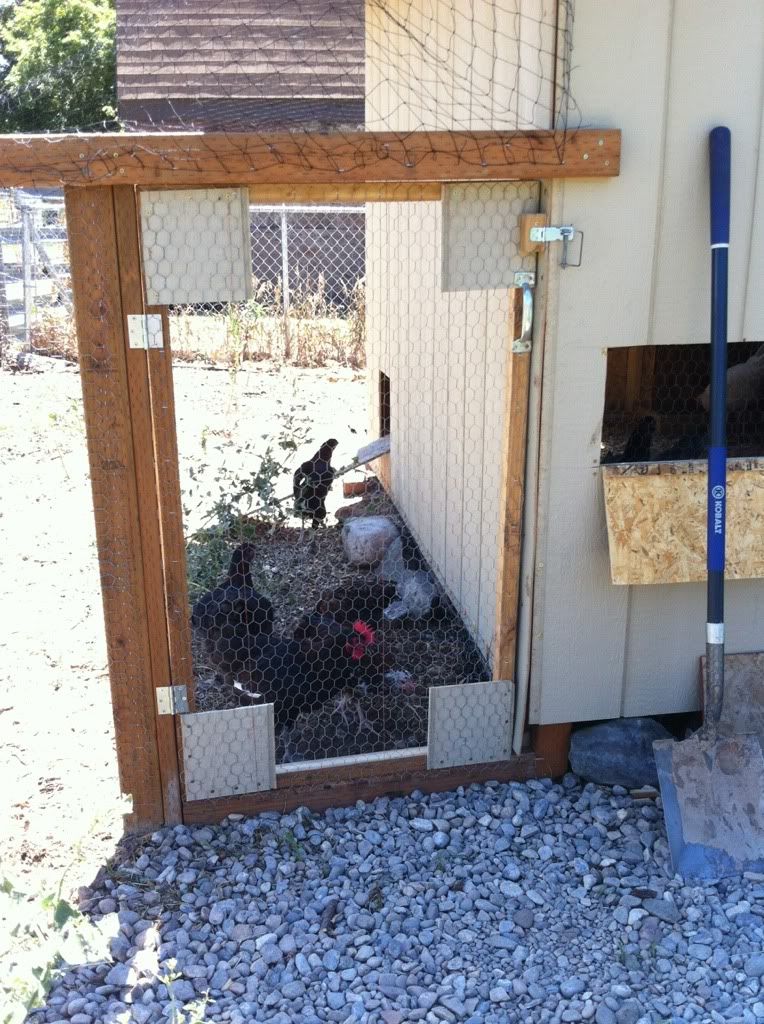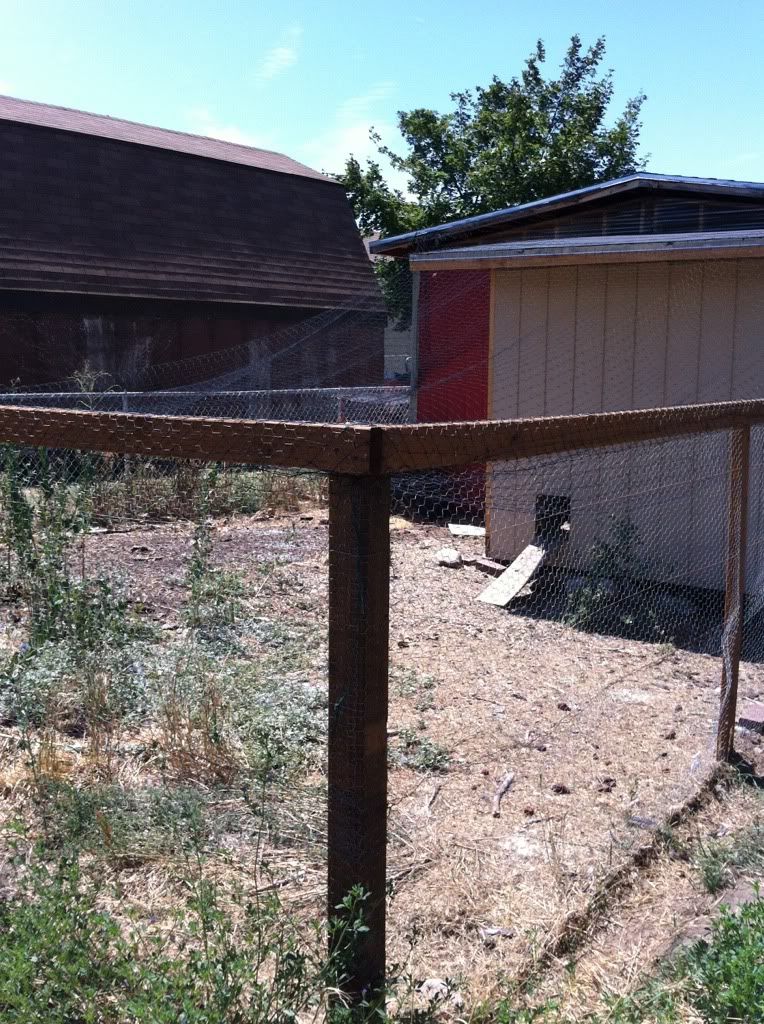I have finally given in to the compulsion I've been having ever since Indy, my Cream Legbar, started laying eggs. I've been dying to hatch some legbars of my own.
So, I've been collecting her eggs for a week. As of today, I have 6 (actually, one of those six is a couple days older and has been in the fridge, so who knows how well it will do) legbar eggs to hatch. There's a 7th egg in there. I suspect it's from my speckled sussex, but I'm not sure.
I'm not sure if they're going to be pure legbar or not. I have three roosters- a legbar, a black copper marans, and a polish. I'm not sure that the polish is getting any action, and I *believe* the legbar is the dominant roo, but I suspect he and the marans have been fighting a bit.
I collected eggs for a friend online- a month ago, he'd asked for fertile eggs for his son's science project. Back in November, I was getting 7-8 eggs a day, so I told him getting two dozen on Dec. 14 wouldn't be a problem at all. Heh. I also said that most of my eggs are pretty easy to tell apart.
Well, all of my chickens with the distinctive eggs stopped laying just before I started collecting. Only Indy, my legbar, was laying colorful eggs. I was getting 2-3 light brown eggs a day, but the only one I was sure on was the speckled sussex. I don't know who the other layers were. -sigh- I tried to watch as carefully as possible, but there were some I just wasn't sure of.
We got to the day before delivery, and I was about 11 eggs short of my promised 24. I got a dozen from my next door neighbor, and those were better in a way because we knew definitely that they were all half blue laced red wyandotte, because her only rooster is one that I gave her from an earlier hatch this year.
His eggs are about 14 days in, and he's had to throw out about 4-5 (all from my neighbor's eggs). Considering they were left in the henhouse overnight, I wonder if they got too cold. I'm excited to see what pops out of his hatch.
Meanwhile, I'm sad that I'm getting no black copper marans eggs, no wellsummer(ish) eggs, no olive eggs, and no polish eggs.
Friday, December 28, 2012
Friday, November 30, 2012
Wow Wow Wubzy
Wow Wow Wubzy is what my kids named our white silkie chick. It's a children's television show character.
I moved the two chicks outside- they're around 8 weeks old now, and I have a 120 watt light out there that keeps things fairly toasty. Things had been going well until this morning.
This morning I found the little silkie dead, and the frizzle all upset. I couldn't find any wounds on her, and she seemed perfectly healthy when I took this picture yesterday. The temperature OUTSIDE didn't even get below 40, and in the henhouse, with 16 other chickens and a warm light, I'm sure it was plenty warm. I'm not sure what happened.
Z, my five year old, was with me when I made the discovery, and he was pretty sad. It's the second chicken he's named, and the first was Hulksmash. So, his track record isn't so great.
S, my seven year old, is going to be so upset when she realizes. The friend who sold them to me says she has more, so I'm trying to figure out a way to go get another while I'm in Salt Lake tomorrow without her realizing it (she'll be with me). I think I may be able to work it out. Wish me luck that I can get a new Wow Wow Wubzy with only Z and my husband the wiser.
Sunday, November 18, 2012
My eggs today
My friend Kris gave me this lovely metal basket that I've been using as my egg collecting basket.
I thought that I'd post the eggs that I collected today because I thought it'd be fun.
I'm thinking that my polish chicken has started to lay because I'm getting an almost white egg now, and she's the only one who would lay that color. But, she took today off (at least, hasn't laid as of 1:30pm) so her egg isn't in here. Maybe I should do this more often.
I get these extra large sized light brown eggs nearly every day. Every time, they're over 60 grams. I think they are from either my golden laced wyandotte or the rhode island red.
Today I got a new egg- I found that medium brown, speckled egg in the small henhouse. I was confused, because it is on the light side for my bcm, but way darker than my other brown eggs. Plus, I'd seen the bcm in the other hen house in the nest box, so I didn't know why I'd find her egg way over here. When I got to the other nest box, I found the obvious bcm egg where I'd seen her earlier. I suspect that pretty, speckled egg comes courtesy of Shirley. Yay!
Rooster Swap
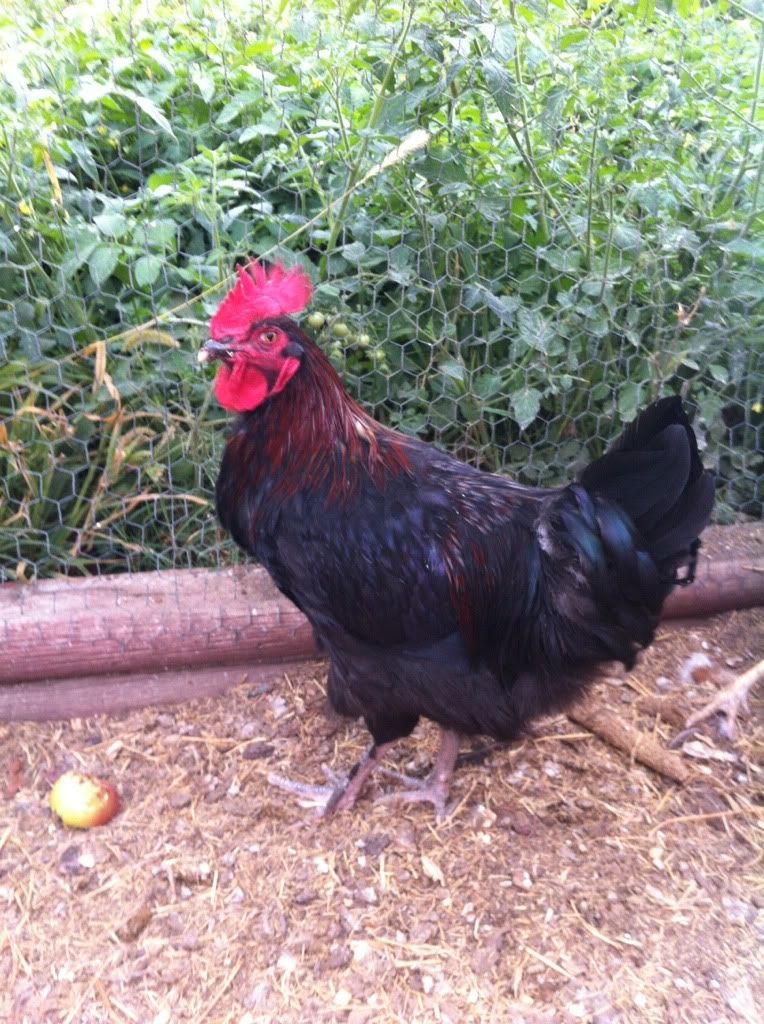 |
| Warren, the Black Copper Marans cockerel |
What sealed the deal was when I was out harvesting potatoes a couple weeks ago, Warren attacked my 5 year old with no provocation. In fact, Z actually had his back to the rooster and he flew at him, knocking him down and scratching him with his spurs.
I'm willing to put up with a little bit of mean for a gorgeous rooster, but if you're homely, you HAVE to be nice to survive at my house.
So, I've known for a while that Warren was on his way out, but hadn't really had time to do anything about it.
Well, about a week ago, my chicken friend Diana posted that a mysterious new rooster magically appeared in her back yard. She went to close in her birds for the night, and there in the middle of everyone was a young black copper marans cockerel. We've joked in our group about "roostering" someone- dropping a rooster into a friend's yard while everyone is asleep. And, since this sort of practical joke is right up my alley, I think she suspected me. I promised I was innocent, but that I would be interested in trading roosters. Her friend, a vet, is wanting to investigate de-crowing a rooster, but since the procedure is a bit tricky, with a high mortality rate, she didn't want to experiment with an expensive rooster.
Yesterday, I dropped Warren off. I'm not sure if he'll have the de-crowing procedure done on him, or if she's going to have him for dinner, but really study his vocal cords before she eats him, but I think it's an intriguing idea. I think ultimately, if decrowing roosters could become more feasible, it would save a lot of roosters lives.
I can't remember what Diana named this boy, but given his magical appearance, I wanted to name him after a magician, so I went for the most legendary musician of all time.
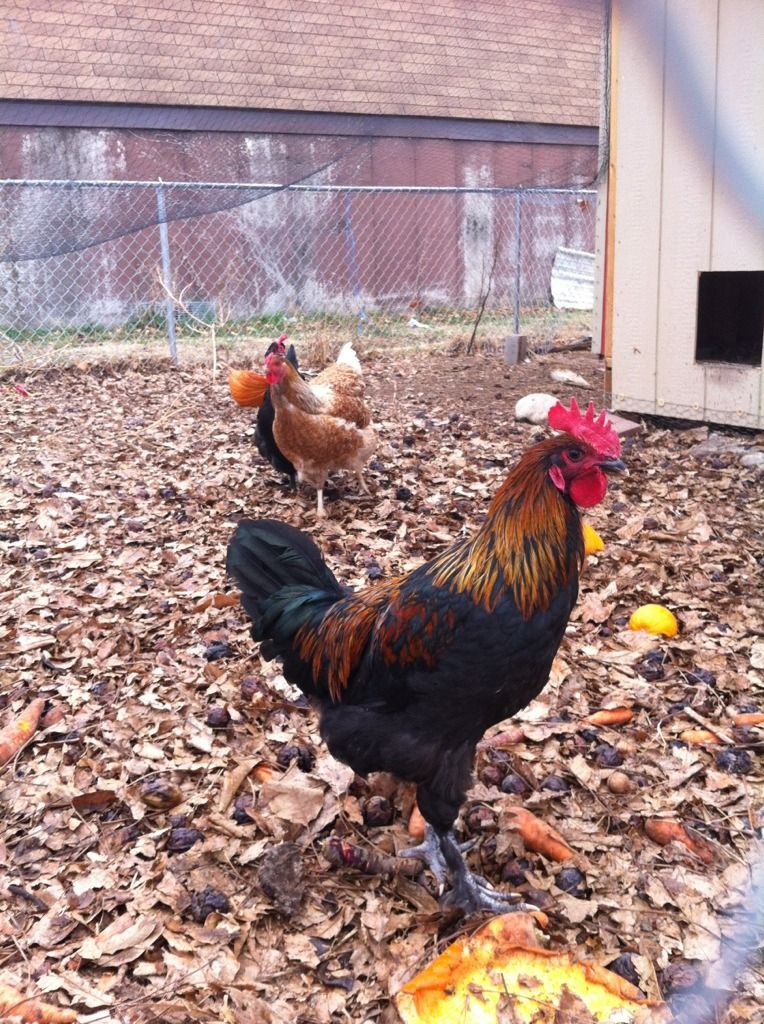 |
| Houdini, black copper marans cockerl |
I put him in the coop last night after everyone was down for the night. This morning, I went to check on him, and found him nestled in a nest box with my bcm, who was trying to lay, and looking very annoyed with him for intruding on her space. So far, he seems to be getting along well with everyone.
Monday, November 12, 2012
Poor Chickensitters
I wonder why it is that all unusual stuff happens when I go out of town. I swear I'm not gone that often, but when I am, that's when the weird happens.
I was planning to go to Las Vegas this past weekend. I toyed with the idea of not having someone collect eggs at all because I didn't want to inconvenience anyone. A girlfriend called the day before I left and wanted to buy eggs. I told her that if she came and collected while I was gone, she could keep anything she collected for free.
She came over the day before I left so I could show her what to do. I noticed my older lavender ameraucana in the nest box. This has been happening more and more, and I'd been concerned- I'd see her in the box, but then she'd never lay anything. I have found 4-5 "fart eggs" that I was guessing were coming from her. I've started to be concerned that she was laying internally, or that something wasn't right with her.
I warned T of my concerns, and said if something happened, I wouldn't be too surprised.
As it turns out, the chicken did pass away on Saturday. I feel bad about it. I'm wondering if maybe the chickens were possibly too closely bred? That means I lost both of them within a few months, and definitely prematurely. I'm thinking my chicken babysitter wasn't too broken up though- she told me she collected well over a dozen eggs, and she kind of wants chickens now.
On a happier note, my speckled sussex has begun laying. I think she actually started a couple weeks ago. There's another egg that's started appearing that's a very, very pale cream color. Definitely not white, but very light. Maybe it belongs to the coronation sussex? I haven't been able to catch the hen in the act.
I was planning to go to Las Vegas this past weekend. I toyed with the idea of not having someone collect eggs at all because I didn't want to inconvenience anyone. A girlfriend called the day before I left and wanted to buy eggs. I told her that if she came and collected while I was gone, she could keep anything she collected for free.
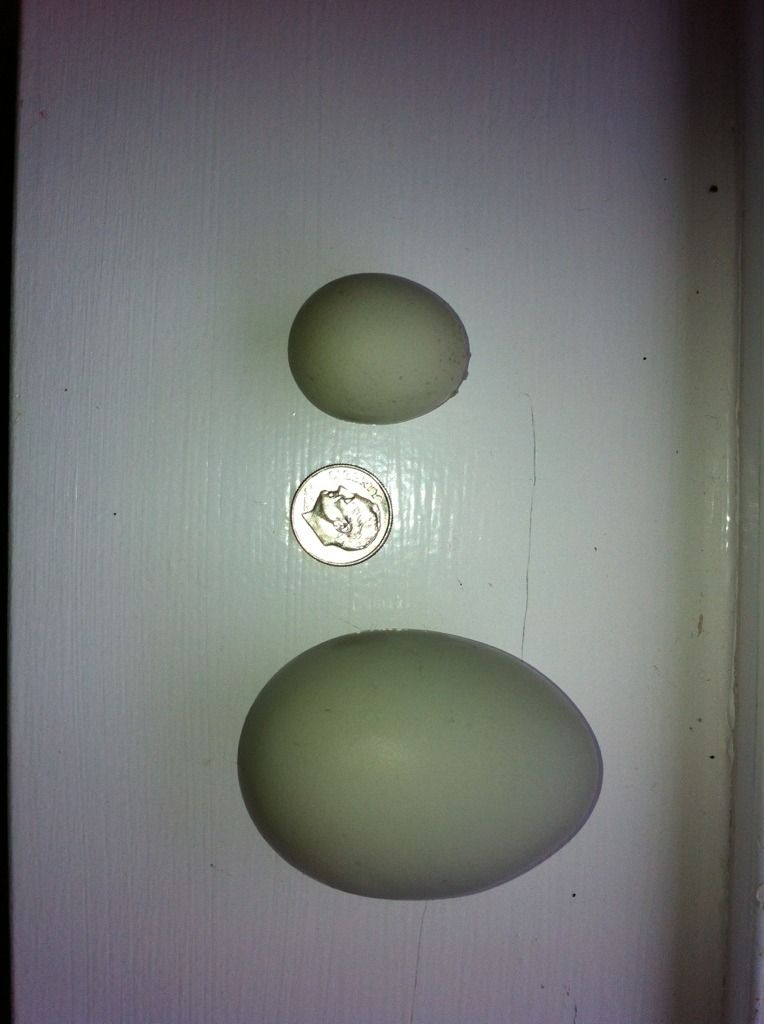 |
| fart egg on top |
I warned T of my concerns, and said if something happened, I wouldn't be too surprised.
As it turns out, the chicken did pass away on Saturday. I feel bad about it. I'm wondering if maybe the chickens were possibly too closely bred? That means I lost both of them within a few months, and definitely prematurely. I'm thinking my chicken babysitter wasn't too broken up though- she told me she collected well over a dozen eggs, and she kind of wants chickens now.
On a happier note, my speckled sussex has begun laying. I think she actually started a couple weeks ago. There's another egg that's started appearing that's a very, very pale cream color. Definitely not white, but very light. Maybe it belongs to the coronation sussex? I haven't been able to catch the hen in the act.
Tuesday, October 30, 2012
Potato Farmers
I let all of the big kids out to free range while I harvested potatoes. They thought it was the funniest thing that I was scratching around in the dirt like them, and were constantly underfoot, especially the lavender ameraucana.
Tuesday, October 23, 2012
Who will lay next?!
Amongst the big kids, I have four pullets that have not started laying. Who do you think will lay next?
Of the group, Carrie, the speckled sussex, is the oldest. She's suddenly turned very red in the face, and I've seen her checking out the nest boxes. As of now, she is around 25ish weeks. I didn't hatch her, so I don't know for sure.
Next oldest is Thing 1. I didn't hatch her either, but I imagine she's very close in age to Carrie, so I'd guess 24 weeks old or so.
Next up is Shirley, the hen I saved from the eating basket. When I picked up eggs for my final school hatch, the 7th egg was a lovely blue egg, but it was kind of a strange, oblong shape. I worried that it wouldn't rotate correctly in the incubator, so I asked if I could swap it for a different egg. On the counter, she had a basket full of eggs that she'd collected for eating. I chose a pretty brown egg, and Shirley was the result. I think she may be a welsummer mix, or possibly a black sex link. Shirley is 21 weeks old.
Youngest of the bunch, but easily the biggest hen I own is Chloe. Cloe is the last to hatch from the batch that Shirley came from, and she was late and seemed to be struggling, so I helped her out. She bled a bit upon hatch, which made me feel awful, that I'd killed her. She also had curled toes that I had to fix. But look at her now! I am so thrilled with how beautifully she's turned out. I have no idea if she's "show quality" or not, but I sure think she's pretty.
I think my money is on either Chloe or Carrie laying first, but I think it'll be Carrie. I think that Thing 1 will be the last to lay.
 |
| Carrie the Speckled Sussex |
Of the group, Carrie, the speckled sussex, is the oldest. She's suddenly turned very red in the face, and I've seen her checking out the nest boxes. As of now, she is around 25ish weeks. I didn't hatch her, so I don't know for sure.
 |
| Thing 1 |
Next oldest is Thing 1. I didn't hatch her either, but I imagine she's very close in age to Carrie, so I'd guess 24 weeks old or so.
 |
| Shirley the adorable mutt |
 |
| Chloe the Coronation Sussex |
Youngest of the bunch, but easily the biggest hen I own is Chloe. Cloe is the last to hatch from the batch that Shirley came from, and she was late and seemed to be struggling, so I helped her out. She bled a bit upon hatch, which made me feel awful, that I'd killed her. She also had curled toes that I had to fix. But look at her now! I am so thrilled with how beautifully she's turned out. I have no idea if she's "show quality" or not, but I sure think she's pretty.
I think my money is on either Chloe or Carrie laying first, but I think it'll be Carrie. I think that Thing 1 will be the last to lay.
Integration
After losing a couple chickens, I'd decided I wanted to keep my two flocks separate for a few months to make sure that I didn't have a huge outbreak of LL. However, since a couple months went by with nothing, and the temperatures are starting to drop, I decided to integrate. The idea of buying two water heaters, having two supplemental lights set up, etc. etc got to buy a little overwhelming.
I wanted the two groups to have a couple "playdates" before I took down the fence that separated the two coops. So, while I would be outside working on putting the garden to bed, I'd let everyone out so they could free range together. Everyone seemed to get along really well, so after a few days of that, I took down the fence. It seems to have gone fairly smoothly. My two roosters have been going at it a little bit, I think- both of them have slightly scabby combs, but they don't fight in front of me at all. It's kind of funny though- a couple of Jones' hens will sit there and almost groom his comb and wattles. They remind me of groupies. Jones is the white legbar rooster.
I will admit he cuts a more dashing figure than Warren, the black copper marans. But, I suspect Warren is going to get better looking as he comes into himself. Even at his best, he's not going to be a very good example of a black copper marans- his color is too dark, more of a mahogany than an orange color. I also suspect his shape isn't great. his tail has some white, which is bad, but that could go away with his first molt.
Meanwhile, poor lonely Fonzie kept escaping from his corner of the coop so often that I finally gave up on protecting him from the rest. I think he's just so desperate to be part of the flock that he's willing to put up with their abuse. He's so small that he can escape through the chain link if needs' be. When I go out there, he comes running, and if I don't pick him up, he tries to fly up to me. Little bugger is growing on me. I can't have a FOURTH rooster, so I'm hoping he either turns mean or I'm wrong and Fonzie is actually a girl.
Everyone is still sleeping in their original quarters though- zero integration at night. Egg laying was segregated until yesterday- I found a marans egg in the other coop. Otherwise, they've kept that separate as well.
 |
| Jones and his fan club |
 |
| Warren the Black Copper Marans |
I will admit he cuts a more dashing figure than Warren, the black copper marans. But, I suspect Warren is going to get better looking as he comes into himself. Even at his best, he's not going to be a very good example of a black copper marans- his color is too dark, more of a mahogany than an orange color. I also suspect his shape isn't great. his tail has some white, which is bad, but that could go away with his first molt.
Meanwhile, poor lonely Fonzie kept escaping from his corner of the coop so often that I finally gave up on protecting him from the rest. I think he's just so desperate to be part of the flock that he's willing to put up with their abuse. He's so small that he can escape through the chain link if needs' be. When I go out there, he comes running, and if I don't pick him up, he tries to fly up to me. Little bugger is growing on me. I can't have a FOURTH rooster, so I'm hoping he either turns mean or I'm wrong and Fonzie is actually a girl.
Everyone is still sleeping in their original quarters though- zero integration at night. Egg laying was segregated until yesterday- I found a marans egg in the other coop. Otherwise, they've kept that separate as well.
Thursday, October 11, 2012
New Egg Layers!!
I am so excited! I have three pullets and one rooster from my preschool hatch. I gave the other hen to my sister in law, and sold the other rooster. As of this week, they are now 26 weeks old.
Two days ago, I found a lovely green egg in the run. It was the same color as my old easter egger used to lay, and the exact same shade as my front room wall. I was kind of hoping it came from the lighter lavender ameraucana in that batch because I wanted Cinderella, my olive egger, to give me a very dark egg.
Yesterday, I went out to check for eggs again. In the time out corner, where Fonzie's been living, I found my black copper marans pullet (from that hatch). No sign of Fonzie. The black copper marans was not at all happy to be in there, and seemed trapped. Also in there was another green egg.
I lifted her out and grabbed the egg. I was a little concerned that even though she was SUPPOSED to be a bcm, maybe she was some mix. I didn't think so though. She looked like a hen on an egg laying mission.
Sure enough, a couple hours later, I found a nice marans egg out in the run. Yay!! Two out of the three are laying.
I did some decorating of my nest boxes- added carpet and then shavings in the bottom. Then, as a temporary measure, I moved a rubbermaid tote under the boxes so they could hop up there easier. Immediately felt like an idiot because I watched Cinderella, the dark gray pullet from that hatch JUMP 6 feet into the air and land on my storage shelf at the top of the room. I helped her down, and then she hopped into one of my newly done nest boxes. All the other chickens in the hen house started singing the egg song except her.
After a few minutes, I found that same nice green egg in there. So, I think I'll have to be working on getting another olive egger in the future. But, this is a pretty color.
Two days ago, I found a lovely green egg in the run. It was the same color as my old easter egger used to lay, and the exact same shade as my front room wall. I was kind of hoping it came from the lighter lavender ameraucana in that batch because I wanted Cinderella, my olive egger, to give me a very dark egg.
Yesterday, I went out to check for eggs again. In the time out corner, where Fonzie's been living, I found my black copper marans pullet (from that hatch). No sign of Fonzie. The black copper marans was not at all happy to be in there, and seemed trapped. Also in there was another green egg.
I lifted her out and grabbed the egg. I was a little concerned that even though she was SUPPOSED to be a bcm, maybe she was some mix. I didn't think so though. She looked like a hen on an egg laying mission.
Sure enough, a couple hours later, I found a nice marans egg out in the run. Yay!! Two out of the three are laying.
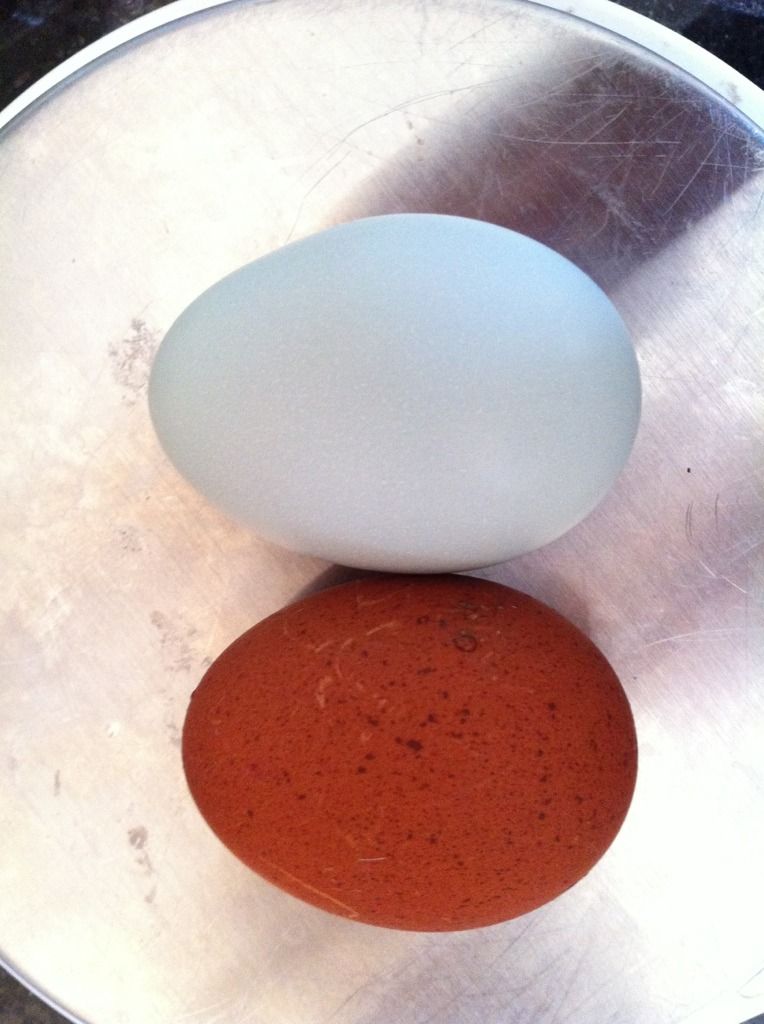 |
| Cream legbar egg on top, Black Copper Marans pullet egg on bottom |
I did some decorating of my nest boxes- added carpet and then shavings in the bottom. Then, as a temporary measure, I moved a rubbermaid tote under the boxes so they could hop up there easier. Immediately felt like an idiot because I watched Cinderella, the dark gray pullet from that hatch JUMP 6 feet into the air and land on my storage shelf at the top of the room. I helped her down, and then she hopped into one of my newly done nest boxes. All the other chickens in the hen house started singing the egg song except her.
 |
| Cinderella at the top of the chicken coop |
After a few minutes, I found that same nice green egg in there. So, I think I'll have to be working on getting another olive egger in the future. But, this is a pretty color.
Teaching Chickens to use a Nipple Watering System
When I introduced my big buckets with nipple waterers on bottom in the first place, my chickens got the hang of it after a couple days. I just had them watch while I toggled a nipple with my finger, and after a few minutes, they just picked up on it.
I lost Potsy to misunderstanding the watering system (which is odd, because she'd had it in the house and used it with no problems) and nearly lost Fonzie.
I was determined to really watch the new chicks and make sure they got the concept down. They didn't. It was maddening. I could tell they were thirsty. I would use my finger to make water come out of the bottle, but they didn't get it. After a day or so, they got all excited when they saw my finger, as they saw it, it was the magical water dispensing finger. Yesterday, at wits end, I ended up squeezing the water bottle. It is soft enough that it forced water to slowly drip out. They saw that, and a light bulb went on. Within a couple minutes, everyone was drinking from the nipple, and all was well.
I've heard of adult chickens continuing to have a problem, and my fix won't work if it's a 5 gallon bucket. I haven't tried this, but it makes sense. Someone suggested using grapes or cherry tomatoes, and carefully sticking them over the nipples. The chickens will nibble at their treat, and by the time the treat is gone, they'll have realized there's water coming out of that strange, silver contraption.
I lost Potsy to misunderstanding the watering system (which is odd, because she'd had it in the house and used it with no problems) and nearly lost Fonzie.
I was determined to really watch the new chicks and make sure they got the concept down. They didn't. It was maddening. I could tell they were thirsty. I would use my finger to make water come out of the bottle, but they didn't get it. After a day or so, they got all excited when they saw my finger, as they saw it, it was the magical water dispensing finger. Yesterday, at wits end, I ended up squeezing the water bottle. It is soft enough that it forced water to slowly drip out. They saw that, and a light bulb went on. Within a couple minutes, everyone was drinking from the nipple, and all was well.
I've heard of adult chickens continuing to have a problem, and my fix won't work if it's a 5 gallon bucket. I haven't tried this, but it makes sense. Someone suggested using grapes or cherry tomatoes, and carefully sticking them over the nipples. The chickens will nibble at their treat, and by the time the treat is gone, they'll have realized there's water coming out of that strange, silver contraption.
A funny thing happened at the feed store...
So. A funny thing happened to me at the feed store today. As we were driving there, my 7 year old asked if we could get a chick. I said, "Oh honey, they don't have chicks this time of year" ("thank goodness" under my breath).
So we get there, and the manager is telling about how a month or so ago, someone dumped a bunch of hens over the fence into their back lot overnight. George, one of the roosters, decided they were his new flock and was hanging out with them. A couple days ago, they realized that a bunch of chicks had hatched from these rogue hens. Some customers yesterday caught all but one of the hens. They thought they'd gotten all the chicks, but it turns out there was a broody banty mama with a bunch of chicks. There's also a bunch of feral cats and kittens out there, so she was a bit worried. I offered to help an employee capture everyone. So, we get this tiny little mama captured, and her TEN chicks. As we caught them, we were talking about how we could make a safe area in the petting zoo part of the store for the mom.
We get inside, and the manager announces I'm taking them all home. Ummmm, NO!!! Another customer was in there, and he was perfectly happy to take them all. I ended up deciding to take one home, because it's such a funny story.
This little girl (?) definitely takes after her daddy. He's a big, dark blue rooster. I think he is probably a Blue Langshan. Mom was a little bantam. I believe she may be an Old English Game Hen. Three of the chicks were yellow, the other seven looked more or less like my chick.
Sunday, October 7, 2012
Loss and Gains
Sadly, I lost Potsy. Unfortunately, I think it's my fault. I moved the chicks outside a week or so ago. Their water container was changed with the move. Instead of being a clear bottle with a silver tip, it was a green bottle with a red tip. I showed the chicks where to get water, but I got really busy, and didn't really check closely to make sure their water levels were going down. She died a few days later. The next morning, I found Fonzie laying on the ground. Noticing that the water seemed awfully full. I toggled with the nipple and found it to be completely dry, a sure sign they hadn't been using it. I made him drink from the cow trough, and then showed him again how to use it. Within a few minutes, he perked up, and has been drinking from the watering system just fine. I feel bad that I didn't notice Potsy going downhill though.
This evening, I picked up three new chicks. I am so excited!
First off, we have WowWowWubsy (my 5 year old named it). She (?) is a white silkie.
Next, we have Lucy, a Patridge Sizzle.
Last, and my favorite, is Diana, a Wheaton Frizzle.
This evening, I picked up three new chicks. I am so excited!
First off, we have WowWowWubsy (my 5 year old named it). She (?) is a white silkie.
Next, we have Lucy, a Patridge Sizzle.
Last, and my favorite, is Diana, a Wheaton Frizzle.
Tuesday, September 11, 2012
Another One Bites the Dust
Last night, I was checking on my chickens before bed. In the "clean" pen, I noticed that Fred, my BLRW from my daughter's classroom hatch, was not on the perch with the other chickens. I found it odd and troubling.
This morning, I went to check on her, and found her in the henhouse instead of out with everyone else. She was kind of sitting low and was really puffed up. I knew this was a bad sign, so I separated her from the others.
Within six hours, she was dead. I happened to have friends over when she finally passed, and one of them dug the hole for me, which was nice. All of the recent rain made the digging go very quickly.
I am feeling sad about the whole thing, and also extremely frustrated. I honestly believe the three deaths are unrelated. Fred was never exposed to either of the other two chickens.
As I was really getting warmed up for my pity party, I remembered Fred's life, and some things kind of possibly clicked into place. Fred was the last of the chicks to hatch in my daughter's class, and she was really, really overdue. She's also been a lot smaller than her hatchmates. I'm now wondering if maybe she had something wrong with her from the beginning, and it just finally caught up with her?
I told my seven year old, and she took the news fairly well. She was sad, of course, but she accepted the news.
I was going to post a picture of her with this "obituary", but I can't find a recent one. My husband will be shocked- he is appalled at the sheer number of photos I have of my chickens.
This morning, I went to check on her, and found her in the henhouse instead of out with everyone else. She was kind of sitting low and was really puffed up. I knew this was a bad sign, so I separated her from the others.
Within six hours, she was dead. I happened to have friends over when she finally passed, and one of them dug the hole for me, which was nice. All of the recent rain made the digging go very quickly.
I am feeling sad about the whole thing, and also extremely frustrated. I honestly believe the three deaths are unrelated. Fred was never exposed to either of the other two chickens.
As I was really getting warmed up for my pity party, I remembered Fred's life, and some things kind of possibly clicked into place. Fred was the last of the chicks to hatch in my daughter's class, and she was really, really overdue. She's also been a lot smaller than her hatchmates. I'm now wondering if maybe she had something wrong with her from the beginning, and it just finally caught up with her?
I told my seven year old, and she took the news fairly well. She was sad, of course, but she accepted the news.
I was going to post a picture of her with this "obituary", but I can't find a recent one. My husband will be shocked- he is appalled at the sheer number of photos I have of my chickens.
Tuesday, September 4, 2012
Update and New Layer!
Today I exchanged a few emails with the vet at the extension. Evidently disposal of the animal is included, but that's just tossing out in the landfill (admittedly, I have no problem with this, even though that probably makes me a heartless pet owner). If I chose to incinerate, it was an extra charge. When I mentioned that I didn't see landfill as an option, and why I chose it, she said she would reverse that charge, which I thought was very decent of her. I also thought it was very kind of her to answer my questions about my flock. I've been losing sleep over what I could be facing, and she helped put my mind at ease.
Essentially, LL is incredibly common in the chicken community. She used the term ubiquitous, which is such a lovely word, and not used frequently enough. Ubiquitous means that it's found everywhere- more than 90% of chickens have been exposed to it. She said that the only way to guarantee a flock is LL free is to have each chicken tested before having them join the group, and to be prepared for a lot of positives. Having them actually get the tumors and die is fairly rare. If a flock starts having a lot of losses, it's probably a good idea to cull the rest, but odds are, it won't go that route.
My plan is to keep the remaining six chickens separate for a few more months. If nobody else gets sick, I can basically relax. Yes, they are all exposed, but it sounds like it isn't that big of a deal most of the time.
I also have great news! My cream legbar is officially laying! I was pretty sure that she laid an egg yesterday. My lavender ameraucana eggs have had a particular shape to them (almost pear shaped), and always have some little calcium deposits, called "pimples" on the narrow end, and have a greenish tint. The egg I got yesterday was smoother, more oval shape, no pimples and appeared more blue. Today, I got one of each, so I have my answer!
Ameraucana egg on the left (see the pimples at the very tip?) and Legbar egg on the right.
Essentially, LL is incredibly common in the chicken community. She used the term ubiquitous, which is such a lovely word, and not used frequently enough. Ubiquitous means that it's found everywhere- more than 90% of chickens have been exposed to it. She said that the only way to guarantee a flock is LL free is to have each chicken tested before having them join the group, and to be prepared for a lot of positives. Having them actually get the tumors and die is fairly rare. If a flock starts having a lot of losses, it's probably a good idea to cull the rest, but odds are, it won't go that route.
My plan is to keep the remaining six chickens separate for a few more months. If nobody else gets sick, I can basically relax. Yes, they are all exposed, but it sounds like it isn't that big of a deal most of the time.
I also have great news! My cream legbar is officially laying! I was pretty sure that she laid an egg yesterday. My lavender ameraucana eggs have had a particular shape to them (almost pear shaped), and always have some little calcium deposits, called "pimples" on the narrow end, and have a greenish tint. The egg I got yesterday was smoother, more oval shape, no pimples and appeared more blue. Today, I got one of each, so I have my answer!
Ameraucana egg on the left (see the pimples at the very tip?) and Legbar egg on the right.
Sunday, September 2, 2012
Chick Pictures
Ok, without further ado, here's my chicks:
Named after her auntie, this is Potsy.
And this is Fonz. Pretty sure he's a boy.
And the two of them together:
The other two haven't hatched, and I don't think they will. When I was taking these guys out of the incubator, I checked for pips and found none. I also tapped on both eggs, and didn't hear tapping back. I've always gotten a response when I do that with term, living eggs.
Friday, August 31, 2012
Difficult Decision
I was relieved by the email I received from the vet on the necropsy of the patridge rock chicken. I was so happy to hear that it wasn't a flock health issue. I was also a little happy that I had an egg in lockdown from the deceased chicken, so she could live on.
Then, on Friday, I received the official lab report. It read:
So, it wasn't as simple as originally thought. LL, as lymphoid leukosis is commonly called, is almost as bad as Marek's disease. In a way, it's worse, as Marek's is not transferred vertically (i.e. mother to chick) and LL is. I've been researching like crazy, and I've learned a few things. First, incubation for LL is 4-6 months, and it's generally seen in older chickens. Second, some chickens can be exposed, but never develop the illness. I guess it can be quite common, and doesn't have the mortality rate that Marek's has. Once a chicken develops the tumors, it is always fatal. Because of the incubation period being so long, I feel that I can safely say that my lavender ameraucana death was not related- the two chickens hadn't been in contact with each other that long.
Marek's disease tends to kill chickens earlier, and LL tends to kill later- around 5-8 months of age is the most common age. My partridge was at least 2-3, so I'm not sure what to make of that.
Because the most common way to get LL is to be infected by the mother, I had to make a very tough decision tonight. I have eggs in the incubator, set to hatch tomorrow. I knew that one was from the partridge rock, because she laid it into my hand and then I put it in the incubator. The odds of that chick having this disease was quite high, and I didn't want to risk it infecting the rest of the flock (if it isn't already too late). Do I euthanize it or not?
I finally decided for the good of the flock, and to minimize risk, I would take it out of the incubator. I figure that it's much easier to euthanize an egg than a fluffy chick.
I took it out of the incubator, and decided that I would put it in the freezer, so as to have the end come about as quickly and humanely as possible. I openly admit to crying as I felt it tapping on the shell as I stuck it in the freezer. I plan to leave it there overnight, make sure that it has no chance of being alive, and then I'll bury it in the yard.
My plan for now is to keep the six chickens that were with the partridge rock in their separate coop. I'd planned to mix the flocks soon, but I think I'd better not. I'll keep them all separated for 6 months. If nobody else develops any symptoms, I'll assume that my flock wasn't infected. I could be wrong, but it's my understand that vertical transmission (mother to chick) is much more common than horizontal transmission (chicken to chicken).
I have to admit this discovery has really put a pall on the hatching of these chicks.
I'm also a little upset. When she emailed me in the first place, she indicated that there was no sign of Marek's Disease, which I assumed to mean she didn't see tumors, other than the ovarian one. But, when you read the final report, there was also tumors in the mesentery (basically all that tissue around your digestive organs) and in the small intestine, plus lymphoma. Then, to add insult to injury, they charged me an additional $20 to dispose of the chicken. When I was quoted $38 for the necropsy, I assumed that included disposal. Oh well, live and learn.
Then, on Friday, I received the official lab report. It read:
DIAGNOSES:
Yolk peritonitis, chronic
Lymphoma, ovary, mesentery and small intestine (lymphoid leukosis)
The cause of death is neoplasia involving multiple organs which in this age of a bird, is most consistent with lymphoid leukosis (LL). LL is the most common form in the leukosis/sarcoma group of diseases which includes a variety of tumors in chickens caused by retroviruses. Mortality in affected flocks is usually 1-2%, but can be higher. These viruses are transmitted vertically from hen to chicks and horizontally from bird to bird by direct contact. Most chickens become infected by contact with congenitally infected birds. The primary differential diagnosis is Marek's disease. Marek's disease (MD - herpesvirus) can be impossible to differentiate microscopically, however LL does not usually occur before 14 wks of age and most mortalities are between 24-40 wks with this agent. MD usually occurs earlier with mortalities usually between 10-20 wks of age. Eradication of retroviruses from the flock involves breaking vertical transmission from hen to progeny ( testing hens for viral infection prior to selecting for breeding) and horizontal transmission from bird to bird (separation of known exposed birds from new birds). Control of Marek's disease in a flock involves similar principles as well as vaccination against the virus.
Remains of this bird were incinerated as requested.
So, it wasn't as simple as originally thought. LL, as lymphoid leukosis is commonly called, is almost as bad as Marek's disease. In a way, it's worse, as Marek's is not transferred vertically (i.e. mother to chick) and LL is. I've been researching like crazy, and I've learned a few things. First, incubation for LL is 4-6 months, and it's generally seen in older chickens. Second, some chickens can be exposed, but never develop the illness. I guess it can be quite common, and doesn't have the mortality rate that Marek's has. Once a chicken develops the tumors, it is always fatal. Because of the incubation period being so long, I feel that I can safely say that my lavender ameraucana death was not related- the two chickens hadn't been in contact with each other that long.
Marek's disease tends to kill chickens earlier, and LL tends to kill later- around 5-8 months of age is the most common age. My partridge was at least 2-3, so I'm not sure what to make of that.
Because the most common way to get LL is to be infected by the mother, I had to make a very tough decision tonight. I have eggs in the incubator, set to hatch tomorrow. I knew that one was from the partridge rock, because she laid it into my hand and then I put it in the incubator. The odds of that chick having this disease was quite high, and I didn't want to risk it infecting the rest of the flock (if it isn't already too late). Do I euthanize it or not?
I finally decided for the good of the flock, and to minimize risk, I would take it out of the incubator. I figure that it's much easier to euthanize an egg than a fluffy chick.
I took it out of the incubator, and decided that I would put it in the freezer, so as to have the end come about as quickly and humanely as possible. I openly admit to crying as I felt it tapping on the shell as I stuck it in the freezer. I plan to leave it there overnight, make sure that it has no chance of being alive, and then I'll bury it in the yard.
My plan for now is to keep the six chickens that were with the partridge rock in their separate coop. I'd planned to mix the flocks soon, but I think I'd better not. I'll keep them all separated for 6 months. If nobody else develops any symptoms, I'll assume that my flock wasn't infected. I could be wrong, but it's my understand that vertical transmission (mother to chick) is much more common than horizontal transmission (chicken to chicken).
I have to admit this discovery has really put a pall on the hatching of these chicks.
I'm also a little upset. When she emailed me in the first place, she indicated that there was no sign of Marek's Disease, which I assumed to mean she didn't see tumors, other than the ovarian one. But, when you read the final report, there was also tumors in the mesentery (basically all that tissue around your digestive organs) and in the small intestine, plus lymphoma. Then, to add insult to injury, they charged me an additional $20 to dispose of the chicken. When I was quoted $38 for the necropsy, I assumed that included disposal. Oh well, live and learn.
Wednesday, August 29, 2012
Death and Necropsy
I checked on my patridge Tuesday morning, and she had managed to get herself into the henhouse part of the time out coop, but she was still laying on her side and looked very ill.
I had to run some errands, and when I came home around 2pm, I checked on her again, and found that she had passed away.
Since this was the second chicken death inside a week, and the third out of ordinary event, I decided to have a necropsy done on her. Utah State University has a couple facilities that do this. One is located in Logan, the other in Nephi. Although it was incredibly inconvenient, I decided to drive her up to Logan and have a necropsy done.
I've been in a panic, worrying that it's Mareks, and that I was going to be having a leper colony/death camp on my hands.
When I got there, the vet came out to talk to me about the whole thing. On the intake paper, there was a little line for background info, and I was not sure how to fit everything there. Luckily I was able to verbally tell the vet everything. She wasn't going to give a definitive answer without examining the bird, but she indicated that she thought I'd just had a run of bad luck, and it probably was not mareks or any other infectious disease. Even though it was 4:30pm by the time I got there, she said they'd get to work on the chicken the next morning (this morning).
I heard back from her by 10:00am. Amazingly fast results! This is what her email said:
I am so relieved!
I had to run some errands, and when I came home around 2pm, I checked on her again, and found that she had passed away.
Since this was the second chicken death inside a week, and the third out of ordinary event, I decided to have a necropsy done on her. Utah State University has a couple facilities that do this. One is located in Logan, the other in Nephi. Although it was incredibly inconvenient, I decided to drive her up to Logan and have a necropsy done.
I've been in a panic, worrying that it's Mareks, and that I was going to be having a leper colony/death camp on my hands.
When I got there, the vet came out to talk to me about the whole thing. On the intake paper, there was a little line for background info, and I was not sure how to fit everything there. Luckily I was able to verbally tell the vet everything. She wasn't going to give a definitive answer without examining the bird, but she indicated that she thought I'd just had a run of bad luck, and it probably was not mareks or any other infectious disease. Even though it was 4:30pm by the time I got there, she said they'd get to work on the chicken the next morning (this morning).
I heard back from her by 10:00am. Amazingly fast results! This is what her email said:
the chicken died of chronic yolk peritonitis ( this was going on for days to over a week). There is a mass on the ovary, could be an infection, but more likely a tumor. I will have slides Friday and know more then as to specifically what the mass is, but this is not a flock health issue, so at this point, nothing to worry about with the others. Not an infectious disease. I will let you know more Friday afternoon. Email or call me if you have any questions. Incidentally, there is no evidence of Merek’s disease in this bird.Dr. R
I am so relieved!
Monday, August 27, 2012
Another Chicken Down
Yesterday while I was cleaning out the old coop, I noticed that my partridge rock didn't seem to be quite herself. She seemed a little fluffed up, and wasn't moving as fast as the other chickens. She still was happy to leave the run and go free ranging with everyone else (for the first time ever- this batch hasn't gotten much of a chance to leave their run). Her comb seemed a bit pale as well.
Today, she was markedly worse in the morning. By dinnertime, she was laying on her side.
I've put her in solitary confinement (I'm so glad I have that tiny time-out coop!!), but I'm not at all hopeful for her recovery. If/when she dies, I think I'll have a necropsy done.
Today, she was markedly worse in the morning. By dinnertime, she was laying on her side.
I've put her in solitary confinement (I'm so glad I have that tiny time-out coop!!), but I'm not at all hopeful for her recovery. If/when she dies, I think I'll have a necropsy done.
Sunday, August 26, 2012
Grandchicken Update
At this point, I have about 6 more days til the grandchickens hatch. Two of the lavender ameraucana eggs did not develop, so I'm down to 5 eggs total. A couple of those had been in the fridge for a couple days, so that doesn't seem to have affected them much.
What does have me worried is space. I have three large brown eggs and two small bluish/green eggs. The small eggs appear to have totally filled up the egg space, while the other three are only taking about 70%, and look totally normal.
My biggest concern with hatching pullet eggs is that they'd run out of space before incubation time was complete. That seems to be happening. We'll have to see if I have a good outcome or not.
What does have me worried is space. I have three large brown eggs and two small bluish/green eggs. The small eggs appear to have totally filled up the egg space, while the other three are only taking about 70%, and look totally normal.
My biggest concern with hatching pullet eggs is that they'd run out of space before incubation time was complete. That seems to be happening. We'll have to see if I have a good outcome or not.
RIP Pecky
I don't remember what I had named that Lavender Amercauna, or if she was the one I raised from hatch or got a couple months ago (they looked identical), but my niece named her "Pecky". She was pretty upset when she fell ill.
On Friday morning, I decided to clean out my big chicken coop. I didn't want her breathing all the dust, plus I wanted to clean her corner as well, so I put her out in the grass. She perked up for the first time in a while, and even was eating some of the grass. She'd lost more than half her body weight, so it was nice to see her so happy. When I got done, I couldn't bear to put her back inside because she seemed so much happier on the lawn. So, I got her water near her and a small pile of food. I realized that she was not safe from any predators, and we see hawks almost every day. I knew it was a risk, but at that point, I knew she wasn't going to recover and thought she should be in a happy place. If I was a bit better at owning chickens, I would've euthanized her a couple weeks ago.
I checked on her a couple hours later, and everything was fine.
A couple hours later, I went back outside, and she had died of natural causes. Though part of me was sad, the overwhelming feeling was relief- I knew she wasn't suffering anymore, and I didn't have to worry anymore about her.
I dug a hole a couple feet deep and buried her (not going to eat a chicken that died of illness, and besides, she'd lost so much weight that I don't think it would've been worth the trouble), then stuck a board and a bike frame over the top to discourage predators from digging her up. It was kind of funny, because after the fact, I realized she was only about 5-10' from the chicken run. I started worrying that her smell would attract predators, and they'd attack the other birds. I mentioned to dh that maybe I shouldn't buried her so close to the others. He replied, "I don't they will notice she's there." With that, I realized he thinks I'm a lot crazier than I actually am. He thought I was worried about traumatizing the other birds. Um, no. I'm worried about the smell of decomposing bird will attract dogs, foxes, whatever else, and then they'll notice fresher meat nearby.
On Friday morning, I decided to clean out my big chicken coop. I didn't want her breathing all the dust, plus I wanted to clean her corner as well, so I put her out in the grass. She perked up for the first time in a while, and even was eating some of the grass. She'd lost more than half her body weight, so it was nice to see her so happy. When I got done, I couldn't bear to put her back inside because she seemed so much happier on the lawn. So, I got her water near her and a small pile of food. I realized that she was not safe from any predators, and we see hawks almost every day. I knew it was a risk, but at that point, I knew she wasn't going to recover and thought she should be in a happy place. If I was a bit better at owning chickens, I would've euthanized her a couple weeks ago.
I checked on her a couple hours later, and everything was fine.
A couple hours later, I went back outside, and she had died of natural causes. Though part of me was sad, the overwhelming feeling was relief- I knew she wasn't suffering anymore, and I didn't have to worry anymore about her.
I dug a hole a couple feet deep and buried her (not going to eat a chicken that died of illness, and besides, she'd lost so much weight that I don't think it would've been worth the trouble), then stuck a board and a bike frame over the top to discourage predators from digging her up. It was kind of funny, because after the fact, I realized she was only about 5-10' from the chicken run. I started worrying that her smell would attract predators, and they'd attack the other birds. I mentioned to dh that maybe I shouldn't buried her so close to the others. He replied, "I don't they will notice she's there." With that, I realized he thinks I'm a lot crazier than I actually am. He thought I was worried about traumatizing the other birds. Um, no. I'm worried about the smell of decomposing bird will attract dogs, foxes, whatever else, and then they'll notice fresher meat nearby.
Monday, August 13, 2012
Incubating Grandchickens
I hadn't planned to incubate again til spring, but I got sucked in. A couple of my friends decided to do a hatch along, and since I moved Warren, my french black copper marans in with the "big girls", all their eggs have been fertile. So, I decided to give it a go. The eggs from my lavender ameraucana are tiny though, so I have doubt as to how well they're going to work. Two were actually in the fridge for a couple days. All are around 30 grams, which is pretty tiny for a large fowl hen. She's only been laying about two weeks or so, so they're brand new.
So, I set four lavender ameraucana eggs and three brown eggs. I know one came from the partridge rock. Not sure who the other two are from. The FBCM rooster is the daddy to all. I set them on Saturday, Aug 11, and expect they'll hatch around Sept 1.
Speaking of lavender ameraucanas, my other one has fallen sick. At first, I thought it was an injury, but as time has gone on, I think it's more serious. It's been speculated by vets that she has encephalitis, brought on either by Botulism or possibly West Nile Virus. Considering their food sources, I think West Nile is a more logical explanation. She's been on antibiotics a few days, but there has been little improvement. She can't walk. It's heartbreaking to watch. She's still eating and drinking, but I'm not too hopeful about her chances of survival. Here's how it went down: A week ago, I went to check to make sure everything was going well, and everyone was bedding down for the night. I found the lavender in one of the nest boxes which is really weird- they never sleep in the nest boxes. I was concerned, but not too much. The next morning, she was still in the nest box. I got her out, and discovered she couldn't stand. It seemed like her left side was way more affected that her right side. I separated her from the rest, thinking that maybe the rooster had hurt her- she's only about half the size of him. However, as the day went on, things got worse and worse and she couldn't stand up.
She went on antibiotics a few days ago, and initially seemed to get a little better, but I just haven't seen much improvement in the last few days. I hate the idea of euthanizing her, but she doesn't seem happy or healthy.
I'm concerned that maybe the vet is wrong, and she has something contagious. I'd hate for that to be the case, because that means my entire flock is in danger. However, West Nile is really scary because that means that not only is my flock in danger, but my family as well.
So, I set four lavender ameraucana eggs and three brown eggs. I know one came from the partridge rock. Not sure who the other two are from. The FBCM rooster is the daddy to all. I set them on Saturday, Aug 11, and expect they'll hatch around Sept 1.
Speaking of lavender ameraucanas, my other one has fallen sick. At first, I thought it was an injury, but as time has gone on, I think it's more serious. It's been speculated by vets that she has encephalitis, brought on either by Botulism or possibly West Nile Virus. Considering their food sources, I think West Nile is a more logical explanation. She's been on antibiotics a few days, but there has been little improvement. She can't walk. It's heartbreaking to watch. She's still eating and drinking, but I'm not too hopeful about her chances of survival. Here's how it went down: A week ago, I went to check to make sure everything was going well, and everyone was bedding down for the night. I found the lavender in one of the nest boxes which is really weird- they never sleep in the nest boxes. I was concerned, but not too much. The next morning, she was still in the nest box. I got her out, and discovered she couldn't stand. It seemed like her left side was way more affected that her right side. I separated her from the rest, thinking that maybe the rooster had hurt her- she's only about half the size of him. However, as the day went on, things got worse and worse and she couldn't stand up.
She went on antibiotics a few days ago, and initially seemed to get a little better, but I just haven't seen much improvement in the last few days. I hate the idea of euthanizing her, but she doesn't seem happy or healthy.
I'm concerned that maybe the vet is wrong, and she has something contagious. I'd hate for that to be the case, because that means my entire flock is in danger. However, West Nile is really scary because that means that not only is my flock in danger, but my family as well.
Tuesday, July 31, 2012
Thing 2
Thing 2 has made a rather miraculous recovery. I thought for sure he was going to die, but he is right as rain now.
He's a little hot, so he's drooping his wings down a little. Isn't he handsome though?
He's a little hot, so he's drooping his wings down a little. Isn't he handsome though?
Food and Water Improvements
I was getting tired of how disgusting my chickens' water was getting. It seemed like it was always really dirty, even soon after I'd cleaned out the watering bucket I'd made. I'd heard great things about watering nipple systems, so I bought a 10 pack from http://www.cconly.com/. There was installation instructions with THIS youtube video. It was just as easy as the video showed. I made two watering systems- one for the old coop and one for the new. I also put a nipple in the cap of a liter soda bottle for chicks.
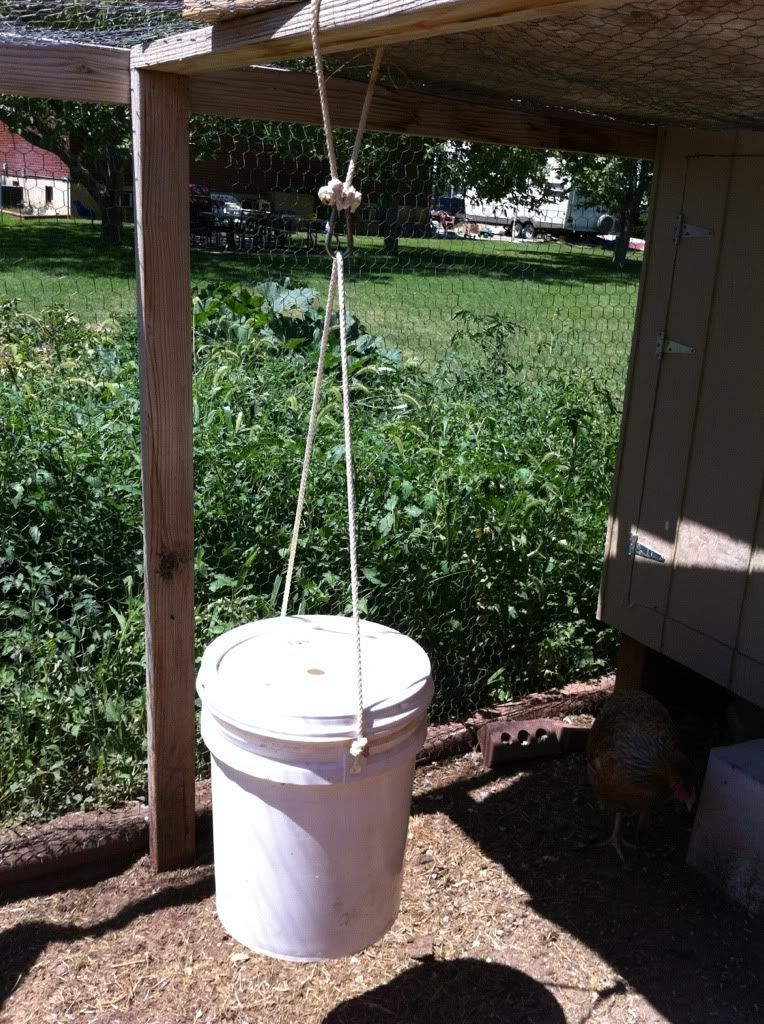 The new coop has the watering system inside, which hasn't been as good. I'm not sure if the nipples leak a little, or if the chickens are just messy drinkers. It's probably a combination of both. But, I had this gooey/wet shavings mess in the bottom of the henhouse. I have been meaning to move it outside, but haven't had time.
The new coop has the watering system inside, which hasn't been as good. I'm not sure if the nipples leak a little, or if the chickens are just messy drinkers. It's probably a combination of both. But, I had this gooey/wet shavings mess in the bottom of the henhouse. I have been meaning to move it outside, but haven't had time.
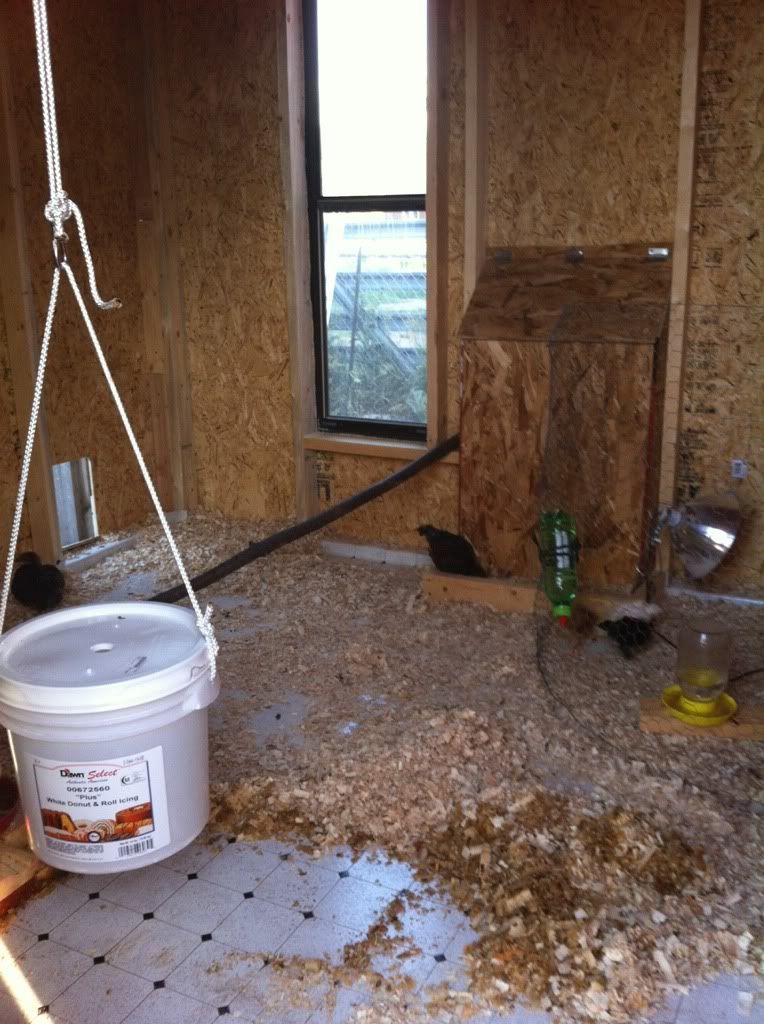
Here's a picture of the new coop, showing the new feeding system and the nipples. Note the mess on the floor.
The chickens figured out how to use the nipples very, very quickly. Best of all, it's easy to keep the water clean.
When winter comes, I'll have to invest in a heater that will go into the bucket to keep the water from melting.
Moving on to the new feedbox.
 Here's after we put the sides up. I wanted it to be tall enough to hold at least 50 lbs of feed, but not so tall that putting the bags in there would be difficult for a shortie like me.
Here's after we put the sides up. I wanted it to be tall enough to hold at least 50 lbs of feed, but not so tall that putting the bags in there would be difficult for a shortie like me.
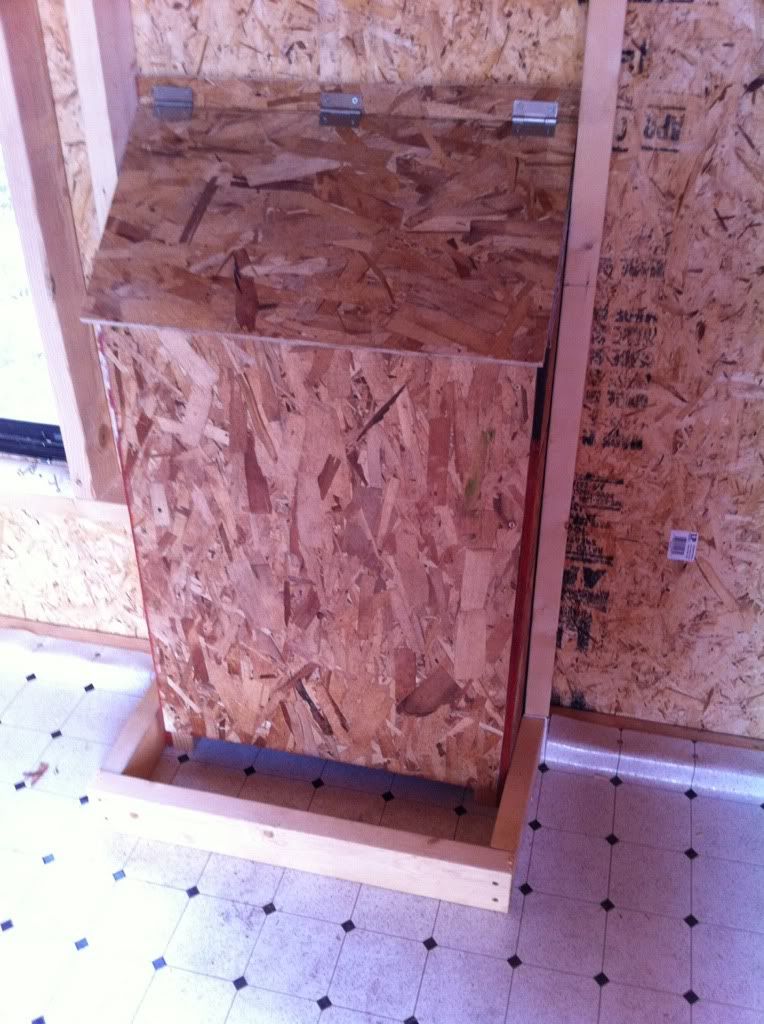 Completed box. Note that top is at an angle to discourage the birds from climbing up there and pooping all over the box and food.
Completed box. Note that top is at an angle to discourage the birds from climbing up there and pooping all over the box and food.
 We put some wood at an angle to encourage the food to go out, and not get stuck in that back corner. This is looking from the top down.
We put some wood at an angle to encourage the food to go out, and not get stuck in that back corner. This is looking from the top down.
You'll note the small hole in the top, where I can just use a hose to fill. We also used a strong rope to attach it. We drilled holes in the bucket so to loop the rope through so that it would be very sturdy. We also used a hook in setting it up so that we could adjust the height if needed.
 The new coop has the watering system inside, which hasn't been as good. I'm not sure if the nipples leak a little, or if the chickens are just messy drinkers. It's probably a combination of both. But, I had this gooey/wet shavings mess in the bottom of the henhouse. I have been meaning to move it outside, but haven't had time.
The new coop has the watering system inside, which hasn't been as good. I'm not sure if the nipples leak a little, or if the chickens are just messy drinkers. It's probably a combination of both. But, I had this gooey/wet shavings mess in the bottom of the henhouse. I have been meaning to move it outside, but haven't had time.
Here's a picture of the new coop, showing the new feeding system and the nipples. Note the mess on the floor.
The chickens figured out how to use the nipples very, very quickly. Best of all, it's easy to keep the water clean.
When winter comes, I'll have to invest in a heater that will go into the bucket to keep the water from melting.
Moving on to the new feedbox.
 Here's after we put the sides up. I wanted it to be tall enough to hold at least 50 lbs of feed, but not so tall that putting the bags in there would be difficult for a shortie like me.
Here's after we put the sides up. I wanted it to be tall enough to hold at least 50 lbs of feed, but not so tall that putting the bags in there would be difficult for a shortie like me. Completed box. Note that top is at an angle to discourage the birds from climbing up there and pooping all over the box and food.
Completed box. Note that top is at an angle to discourage the birds from climbing up there and pooping all over the box and food. We put some wood at an angle to encourage the food to go out, and not get stuck in that back corner. This is looking from the top down.
We put some wood at an angle to encourage the food to go out, and not get stuck in that back corner. This is looking from the top down.
One big problem with our feeder is waste. The chickens are still small enough that they climb inside, and then kick the food out and around. I think most of that will fix itself as they get bigger. I am considering running small wooden dowels across the feeding area to make kicking the feed out more difficult.
Sunday, July 29, 2012
Mystery
Things have been going along pretty uneventfully here. The two January chickens and the plymouth chicken are laying very well. None of the three February chickens are laying yet. We made chicken nipple watering systems and have been thrilled with them.
We left on Thursday to go to Zion National Park for a few days. I asked a friend to look in on the chickens and collect eggs. I told her it was an easy, almost effortless job, and she wouldn't have any trouble. Famous last words.
Friday, I got a panicked phone call from her. When she went to collect eggs, she discovered Thing 1 (one of the polish, and the one I've determined is a pullet) was out of the chicken enclosure. This is very bizarre- we have that thing buttoned up pretty tight, so I'm a little shocked she was out, and still have no idea how that happened. ChickenSitter managed to capture her, and went to put her back in the henhouse. When she opened the door, she discovered Thing 2 (the other polish, and the one I've decided is a cockerel) laying on the floor, unable to move and barely breathing. I called my awesome chicken neighbor, and explained what was going on. She went over and collected Thing 2 and took him home. She fed him water by syringe every half hour until bedtime. Told him that he wasn't allowed to die on her watch. He's an obedient little guy, and lived through the night.
I got home late yesterday afternoon, and found him in pretty rough shape, despite my neighbor's nursing. I made an electrolyte solution, and fed him some poly vil sol (baby vitamins without iron). Amazingly enough, he survived the night again, though he still couldn't stand, and he held his head at a funny angle. He also wouldn't eat.
I was in a panic. I figure it was one of three things:
1- He had been injured somehow, whether by the other chickens or by some ()*^*(&%^ who realized we were out of town, and in the fracas, Thing 1 escaped.
2- He had some VERY TERRIBLE DISEASE, and he, along with the rest of my flock, would be dead shortly.
3- He had wry neck, which can be the result of a vitamin deficiency or poor genetics that make vitamin absorption difficult.
A chicken friend of mine came over, and gave him an injection of dex something or other that is a mild steroid and pain reliever. She also gave him an injection of fluids to help with the dehydration.
A few hours later, he is actually walking around! I don't think he's out of the woods yet, but he seems to be doing better. I gave him some food and he actually ate it. He's also clucking at me. He's recovered enough that he keeps trying to jump out of the little box my neighbor brought him in, so I got out my chick brooder.
I'm supposed to give him another dose of the dex tomorrow, and even though I got clear instructions, I am a little nervous. Here's hoping it goes well.
We left on Thursday to go to Zion National Park for a few days. I asked a friend to look in on the chickens and collect eggs. I told her it was an easy, almost effortless job, and she wouldn't have any trouble. Famous last words.
Friday, I got a panicked phone call from her. When she went to collect eggs, she discovered Thing 1 (one of the polish, and the one I've determined is a pullet) was out of the chicken enclosure. This is very bizarre- we have that thing buttoned up pretty tight, so I'm a little shocked she was out, and still have no idea how that happened. ChickenSitter managed to capture her, and went to put her back in the henhouse. When she opened the door, she discovered Thing 2 (the other polish, and the one I've decided is a cockerel) laying on the floor, unable to move and barely breathing. I called my awesome chicken neighbor, and explained what was going on. She went over and collected Thing 2 and took him home. She fed him water by syringe every half hour until bedtime. Told him that he wasn't allowed to die on her watch. He's an obedient little guy, and lived through the night.
I got home late yesterday afternoon, and found him in pretty rough shape, despite my neighbor's nursing. I made an electrolyte solution, and fed him some poly vil sol (baby vitamins without iron). Amazingly enough, he survived the night again, though he still couldn't stand, and he held his head at a funny angle. He also wouldn't eat.
I was in a panic. I figure it was one of three things:
1- He had been injured somehow, whether by the other chickens or by some ()*^*(&%^ who realized we were out of town, and in the fracas, Thing 1 escaped.
2- He had some VERY TERRIBLE DISEASE, and he, along with the rest of my flock, would be dead shortly.
3- He had wry neck, which can be the result of a vitamin deficiency or poor genetics that make vitamin absorption difficult.
A chicken friend of mine came over, and gave him an injection of dex something or other that is a mild steroid and pain reliever. She also gave him an injection of fluids to help with the dehydration.
A few hours later, he is actually walking around! I don't think he's out of the woods yet, but he seems to be doing better. I gave him some food and he actually ate it. He's also clucking at me. He's recovered enough that he keeps trying to jump out of the little box my neighbor brought him in, so I got out my chick brooder.
I'm supposed to give him another dose of the dex tomorrow, and even though I got clear instructions, I am a little nervous. Here's hoping it goes well.
Tuesday, July 10, 2012
Change in Attitude
I've always been very tender hearted towards animals, even bugs. I won't kill a spider unless it's venomous because I figure it has a right to live (and it'll kill mosquitoes).
However, since I've gotten chickens, I've noticed that my attitude towards predators has definitely shifted. Before, if I saw raccoon or skunk roadkill, I'd be really sad for it.
After my first batch of chickens were killed, I saw a dead raccoon a few days later, and I found myself a little bit happy, mixed with the sad.
That's not to say I go aiming. In fact, I had to slam on my brakes to avoid hitting a raccoon a week ago.
Last week, a neighbor mentioned they'd found a skunk in their back yard. I was really worried because we're in the process of building a much bigger enclosure. Because of that, there's no top. The fence is a little over 5' tall, but nothing overhead. I've ordered poultry netting, but it's not here yet.
So, I've been so worried since I KNOW there's been a skunk within 1000 yards of my chickens.
This morning, I drove past a dead skunk in the road, very close to that neighbor's house. I breathed a sigh of relief, knowing that was probably the intruder.
I'll continue to worry until the netting arrives though.
However, since I've gotten chickens, I've noticed that my attitude towards predators has definitely shifted. Before, if I saw raccoon or skunk roadkill, I'd be really sad for it.
After my first batch of chickens were killed, I saw a dead raccoon a few days later, and I found myself a little bit happy, mixed with the sad.
That's not to say I go aiming. In fact, I had to slam on my brakes to avoid hitting a raccoon a week ago.
Last week, a neighbor mentioned they'd found a skunk in their back yard. I was really worried because we're in the process of building a much bigger enclosure. Because of that, there's no top. The fence is a little over 5' tall, but nothing overhead. I've ordered poultry netting, but it's not here yet.
So, I've been so worried since I KNOW there's been a skunk within 1000 yards of my chickens.
This morning, I drove past a dead skunk in the road, very close to that neighbor's house. I breathed a sigh of relief, knowing that was probably the intruder.
I'll continue to worry until the netting arrives though.
Tuesday, July 3, 2012
Shufflin'
After all of my hatches for the schools, I was up to a total of 24 chickens. Then, my neighbor gave me my gift chicken back. Bow is a Rhode Island Red that she got from the feed store last spring. She turned out to be a mean girl, and was particularly vicious to my neighbor's silver laced wyandottes (SLW). Since my SLW was the queen, J asked me if Bow could come to our coop for a while and get taught a lesson. My girls immediately schooled her and they all got along well. So, J gave her to me. Bow was the only hen to survive the critter attack last November, so I gave her back to the neighbor. Evidently she continued her mean girl ways, so about 6 weeks ago, she came back to our coop. So, up to 25 chickens.
Unfortunately, she was absolutely awful to my new girls, and they were younger and smaller, and didn't try to beat her down, so began a reign of terror.
One of the preschool lavender ameraucanas was definitely a boy, and starting to get a bit agressive, so I sold him. I decided I couldn't handle Bow being such a meanie anymore, so I gave her back to the neighbor. I'd promised my brother in law/sister in law a lavender ameraucana from the preschool hatch, and a blrw (blue laced red wyandotte) from the first grade hatch, so I gave those to them a couple days ago.
When it came to blue laced red wyandottes, I really wanted a true blue one. I have a lovely splash. Out of the seven that I hatched in May, I could tell that all 7 were going to be black, which I think pretty much looks the same as a GLW (golden laced wyandotte), so I decided to keep Fred, the last to hatch of the bunch and sell the other five. Found a buyer last week.
So, I was down to 17. Then I went to the feed store.
Ooooh, that feed store. They always get me in trouble. I had to get a little speckled sussex pullet from them in early May because she was so pretty, and she was the exact same age as the BLRW that I had just hatched. Whoops.
So, I was at the feed store, and the employee knows me by now (which the kids think is HILARIOUS). She sees me, and asks if I'd be possibly interested in a couple of polish chicks she has. They're the same age as my BLRW and speckled sussex. Unfortunately, they've been really picked on by the other chicks, and look really rag tag. They're also straight run, so a big question mark on gender.
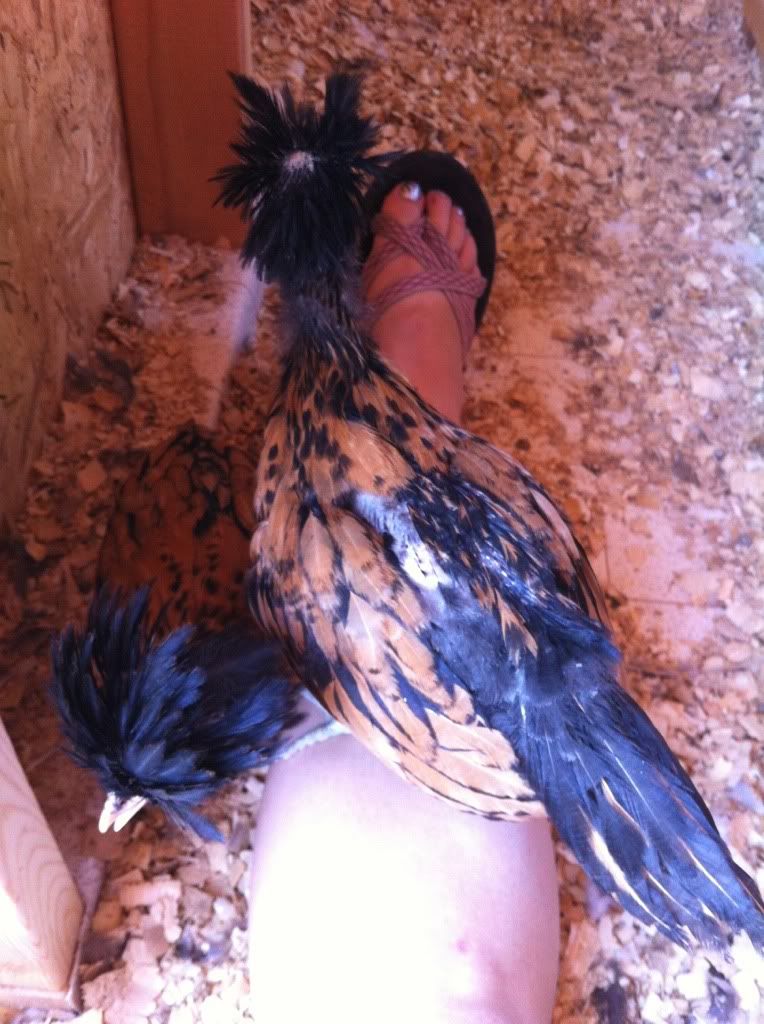
The feed store had done the best they could to get them healed, even employees taking them home to nurse them back to health. At this point, they still have a couple of bald patches, but they are getting better.
So, at this point, I have 19 chickens. I have my two roosters chosen- a White Legbar and a Black Copper Marans. If any more boys pop up, they'll get sold. I suspect both of the polish chickens are pullets (wouldn't that be AWESOME? I got an amazing bargain on them). The only chicks that I'm not sure on gender are the final three hatched.
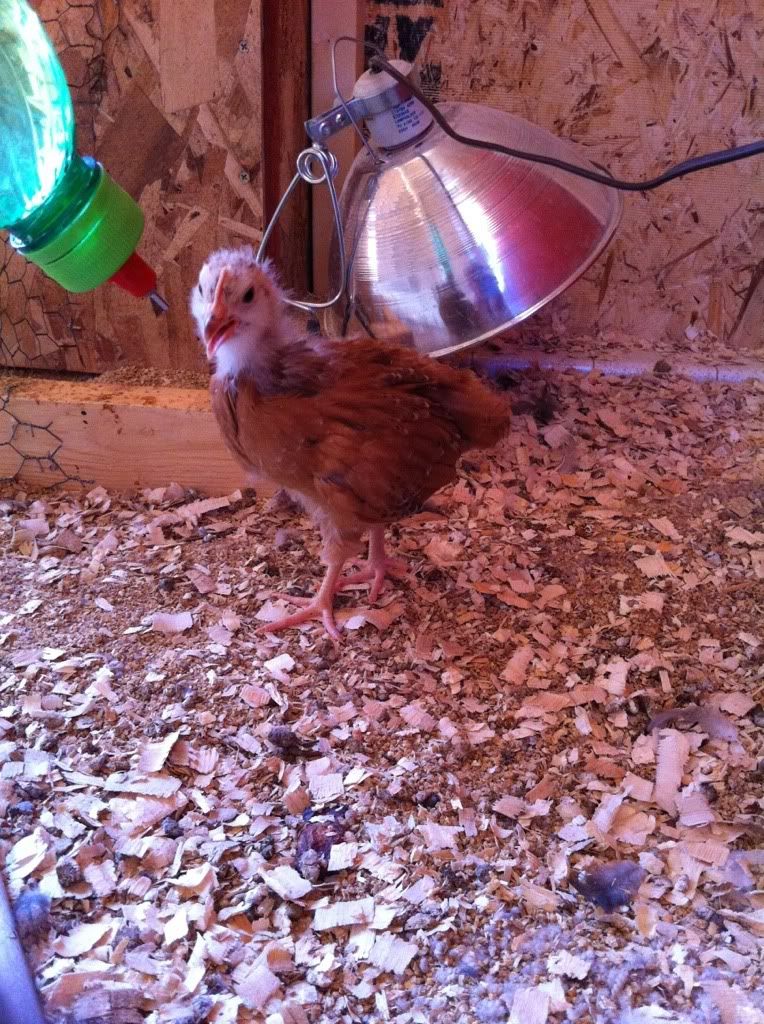
Emily's comb is looking awfully big, which worries me.
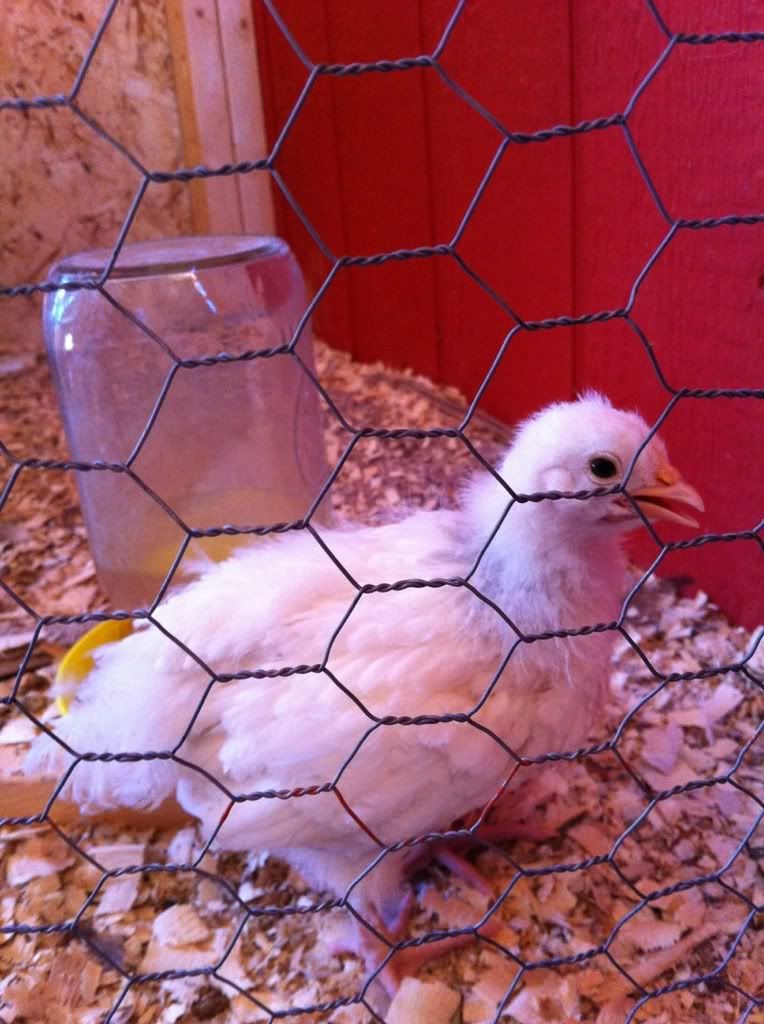
I have no idea on Chloe, the Coronation Sussex.
And, no idea on Shirley, though I'm starting to lean towards pullet, which is funny because at hatch, I was saying Shirley was a cockerel.
Unfortunately, she was absolutely awful to my new girls, and they were younger and smaller, and didn't try to beat her down, so began a reign of terror.
One of the preschool lavender ameraucanas was definitely a boy, and starting to get a bit agressive, so I sold him. I decided I couldn't handle Bow being such a meanie anymore, so I gave her back to the neighbor. I'd promised my brother in law/sister in law a lavender ameraucana from the preschool hatch, and a blrw (blue laced red wyandotte) from the first grade hatch, so I gave those to them a couple days ago.
When it came to blue laced red wyandottes, I really wanted a true blue one. I have a lovely splash. Out of the seven that I hatched in May, I could tell that all 7 were going to be black, which I think pretty much looks the same as a GLW (golden laced wyandotte), so I decided to keep Fred, the last to hatch of the bunch and sell the other five. Found a buyer last week.
So, I was down to 17. Then I went to the feed store.
Ooooh, that feed store. They always get me in trouble. I had to get a little speckled sussex pullet from them in early May because she was so pretty, and she was the exact same age as the BLRW that I had just hatched. Whoops.
So, I was at the feed store, and the employee knows me by now (which the kids think is HILARIOUS). She sees me, and asks if I'd be possibly interested in a couple of polish chicks she has. They're the same age as my BLRW and speckled sussex. Unfortunately, they've been really picked on by the other chicks, and look really rag tag. They're also straight run, so a big question mark on gender.
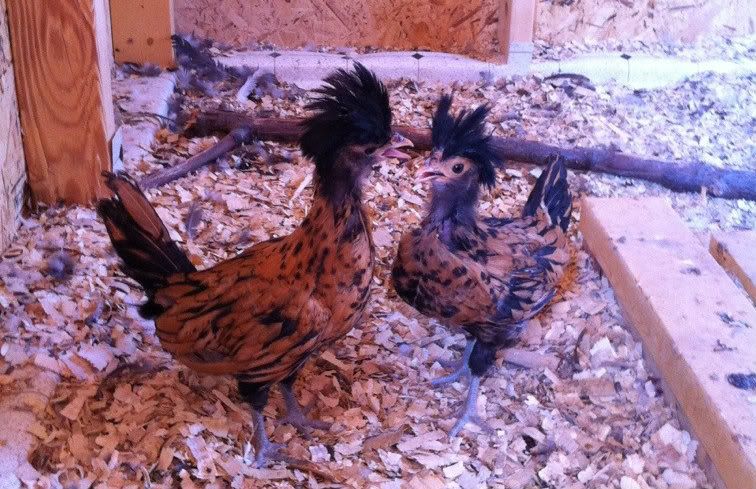 |
| Meet Thing One and Thing Two |

The feed store had done the best they could to get them healed, even employees taking them home to nurse them back to health. At this point, they still have a couple of bald patches, but they are getting better.
So, at this point, I have 19 chickens. I have my two roosters chosen- a White Legbar and a Black Copper Marans. If any more boys pop up, they'll get sold. I suspect both of the polish chickens are pullets (wouldn't that be AWESOME? I got an amazing bargain on them). The only chicks that I'm not sure on gender are the final three hatched.

Emily's comb is looking awfully big, which worries me.

I have no idea on Chloe, the Coronation Sussex.
And, no idea on Shirley, though I'm starting to lean towards pullet, which is funny because at hatch, I was saying Shirley was a cockerel.
Friday, June 15, 2012
Fixing Curled Toes
A couple weeks ago, I posted pictures of my little coronation sussex that I helped hatch. Initially, I was deeply regretful that I'd helped her out; she seemed really in rough shape at first. As she dried off though, I realized her toes were a bit curled. Many people theorize that this can be caused by a delayed hatch. So, I'm trying to console myself with the fact that if I hadn't helped her out, it would've been worse. Maybe this is true, maybe not. I plan to stick with it, and it will cause anguish in future hatches when I have another chick taking its' sweet time.
Leaving cause behind, the fact remained that Chloe had some curled toes. Not a severe case, but a noticeable case nonetheless. I've had a couple chicks have curled toes, but they usually straighten out the first 24 hours or so. Not so, with Chloe. Here's a picture of her feet at 48 hours old.
The left was definitely worse than the right.
I used electrical tape to create a boot of sort. I cut a small piece of tape, and carefully put the foot down onto the sticky side, making sure they were in the correct alignment. Then, I cut another piece of tape and put that over the top, again, being very careful to make sure the toes were perfectly straight and aligned the way they ought to be.
She definitely was NOT happy about it.
I kept the boot on for about 20 hours or so. I was going to be gone the rest of the next day and evening, and didn't want to keep it on when I couldn't be keeping an eye on the chick. So, I saw definite improvement. Maybe it should've been left on longer, but I felt it was better to risk not having a full recovery- I felt like the chick was slipping a bit, and at risk for developing a splayed leg.
Here's how it looked after the first boot:
Definite improvement, but again, not perfect. After I finished my hectic weekend, I decided to tape again. This time, I left the tape on for 3 days or so. Again, I only treated the left foot, the right I just left alone because it just didn't seem that bad.
This is a few days after the second taping, the chick is 16 or so days old.
She is trying to run away from me here, so her stance is a little odd, but this is an action shot.
(oh, and FTR, I have no idea if this chick is a cockerel or a pullet, but I like to think positively, so I refer to the chick as "she")
Leaving cause behind, the fact remained that Chloe had some curled toes. Not a severe case, but a noticeable case nonetheless. I've had a couple chicks have curled toes, but they usually straighten out the first 24 hours or so. Not so, with Chloe. Here's a picture of her feet at 48 hours old.
The left was definitely worse than the right.
I used electrical tape to create a boot of sort. I cut a small piece of tape, and carefully put the foot down onto the sticky side, making sure they were in the correct alignment. Then, I cut another piece of tape and put that over the top, again, being very careful to make sure the toes were perfectly straight and aligned the way they ought to be.
She definitely was NOT happy about it.
I kept the boot on for about 20 hours or so. I was going to be gone the rest of the next day and evening, and didn't want to keep it on when I couldn't be keeping an eye on the chick. So, I saw definite improvement. Maybe it should've been left on longer, but I felt it was better to risk not having a full recovery- I felt like the chick was slipping a bit, and at risk for developing a splayed leg.
Here's how it looked after the first boot:
Definite improvement, but again, not perfect. After I finished my hectic weekend, I decided to tape again. This time, I left the tape on for 3 days or so. Again, I only treated the left foot, the right I just left alone because it just didn't seem that bad.
This is a few days after the second taping, the chick is 16 or so days old.
She is trying to run away from me here, so her stance is a little odd, but this is an action shot.
(oh, and FTR, I have no idea if this chick is a cockerel or a pullet, but I like to think positively, so I refer to the chick as "she")
Wednesday, June 13, 2012
A new and improved coop
Because of my little chicken problem, my husband decided I needed a new chicken coop. He's an engineer, and great with math, so it didn't take much to see the writing on the wall. At the moment, I have 25 chickens. Not all are permanent. My plan is to sell off 6 of the 7 BLRW chicks, and 2-3 of the preschool chicks. So, I figure I'll have 15-16 permanent chickens. Even so, 16 chickens will not comfortably fit in our current coop.
He designed a nice coop that will go on the other side of the shed. It is 8'x8'. The run around it will be approximately 16'x20'. It will connect to the other coop, but with a small door. That way, if I do need to separate groups, it won't be hard. I'll still have my chicken tractor too, which has been extremely handy for growing up chickens- too big to be inside, too small to hang with the big girls.
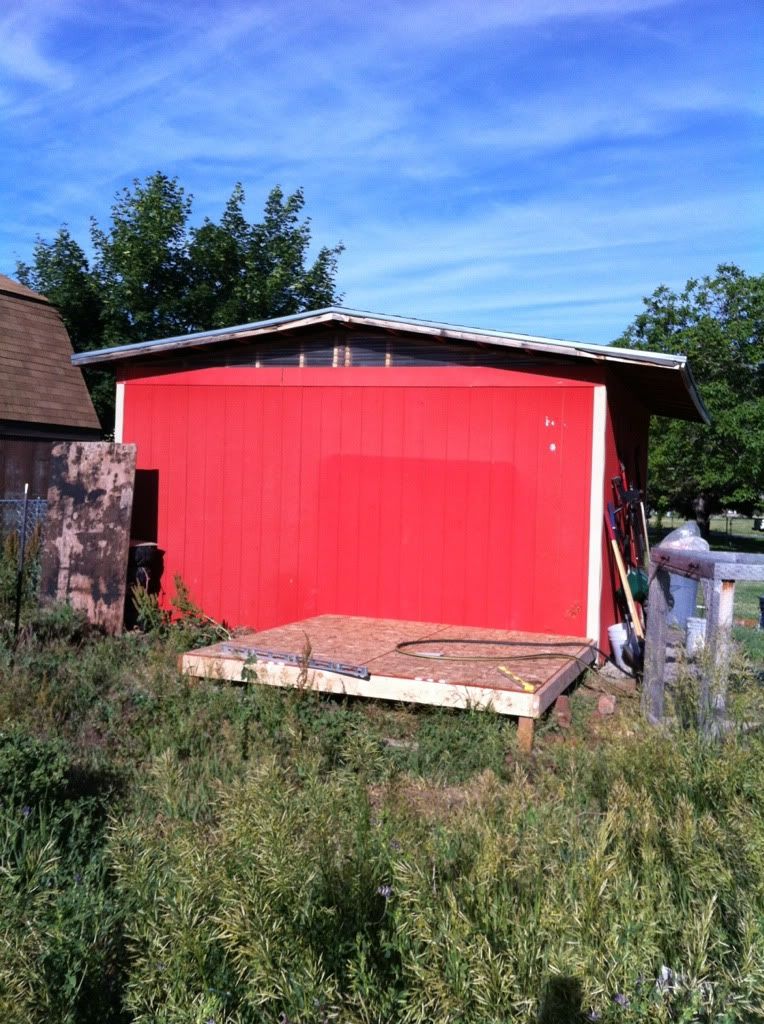
Here's the foundation of the coop. It's butted up against our storage shed. If I'd been there when he started, I would've asked that he raise it up a little bit so the chickens could easily go underneath- have it be maybe two feet off the ground. Because it's lower, I think I'll use chicken wire to block it off so nobody gets any funny ideas about laying eggs under there.
Finished framing, and starting to sheath it.
We bought some vinyl/linoleum to go on the bottom of the coop. I think it'll be easier to clean than wood, and last longer. I bought an 8x12' piece from Home Depot that cost about $50 after tax. The window you see in the background came from Habitat For Humanity's ReStore, which is a home improvement thrift store. I got the window and a door with the necessary hardware and spent under $10. Excellent!
Here's the completed interior. In the corner next to the feed, I've stapled up some chicken wire, making a "time out" corner for smaller/injured/new birds so that they can see everyone, but aren't in any danger of getting beat up by the bigger birds.
Here's the door to the enclosure:
16x-20x enclosure. The sides are a strong guaged chicken wire. When building it, we used pressure treated lumber so it would withstand the elements a bit better. We also dug a trench a foot deep around the enclosure and buried the chicken wire so that digging under would prove more difficult.
The top of the enclosure is a bird netting that I bought on Amazon. We wove it through the chicken wire and stapled it on really well to the posts around the enclosure and the roof of the chicken coop with NO gaps so that it could support some weight. It is a little loose though, so if something did try to think about crawling on top, it would be more like a hammock or safety net, so extremely UNATTRACTIVE to walk on. I've read that raccoons don't like unsteady surfaces, so I'm hoping that be having a floppy, soft, sinking surface, they won't try to climb on top. It's secure enough that I'm sure it could take a medium to large size dog. Said animal would be hopelessly ensnared, but the chickens ought to be safe.
He designed a nice coop that will go on the other side of the shed. It is 8'x8'. The run around it will be approximately 16'x20'. It will connect to the other coop, but with a small door. That way, if I do need to separate groups, it won't be hard. I'll still have my chicken tractor too, which has been extremely handy for growing up chickens- too big to be inside, too small to hang with the big girls.

Here's the foundation of the coop. It's butted up against our storage shed. If I'd been there when he started, I would've asked that he raise it up a little bit so the chickens could easily go underneath- have it be maybe two feet off the ground. Because it's lower, I think I'll use chicken wire to block it off so nobody gets any funny ideas about laying eggs under there.
Finished framing, and starting to sheath it.
We bought some vinyl/linoleum to go on the bottom of the coop. I think it'll be easier to clean than wood, and last longer. I bought an 8x12' piece from Home Depot that cost about $50 after tax. The window you see in the background came from Habitat For Humanity's ReStore, which is a home improvement thrift store. I got the window and a door with the necessary hardware and spent under $10. Excellent!
Here's the completed interior. In the corner next to the feed, I've stapled up some chicken wire, making a "time out" corner for smaller/injured/new birds so that they can see everyone, but aren't in any danger of getting beat up by the bigger birds.
Here's the door to the enclosure:
16x-20x enclosure. The sides are a strong guaged chicken wire. When building it, we used pressure treated lumber so it would withstand the elements a bit better. We also dug a trench a foot deep around the enclosure and buried the chicken wire so that digging under would prove more difficult.
The top of the enclosure is a bird netting that I bought on Amazon. We wove it through the chicken wire and stapled it on really well to the posts around the enclosure and the roof of the chicken coop with NO gaps so that it could support some weight. It is a little loose though, so if something did try to think about crawling on top, it would be more like a hammock or safety net, so extremely UNATTRACTIVE to walk on. I've read that raccoons don't like unsteady surfaces, so I'm hoping that be having a floppy, soft, sinking surface, they won't try to climb on top. It's secure enough that I'm sure it could take a medium to large size dog. Said animal would be hopelessly ensnared, but the chickens ought to be safe.
Subscribe to:
Comments (Atom)


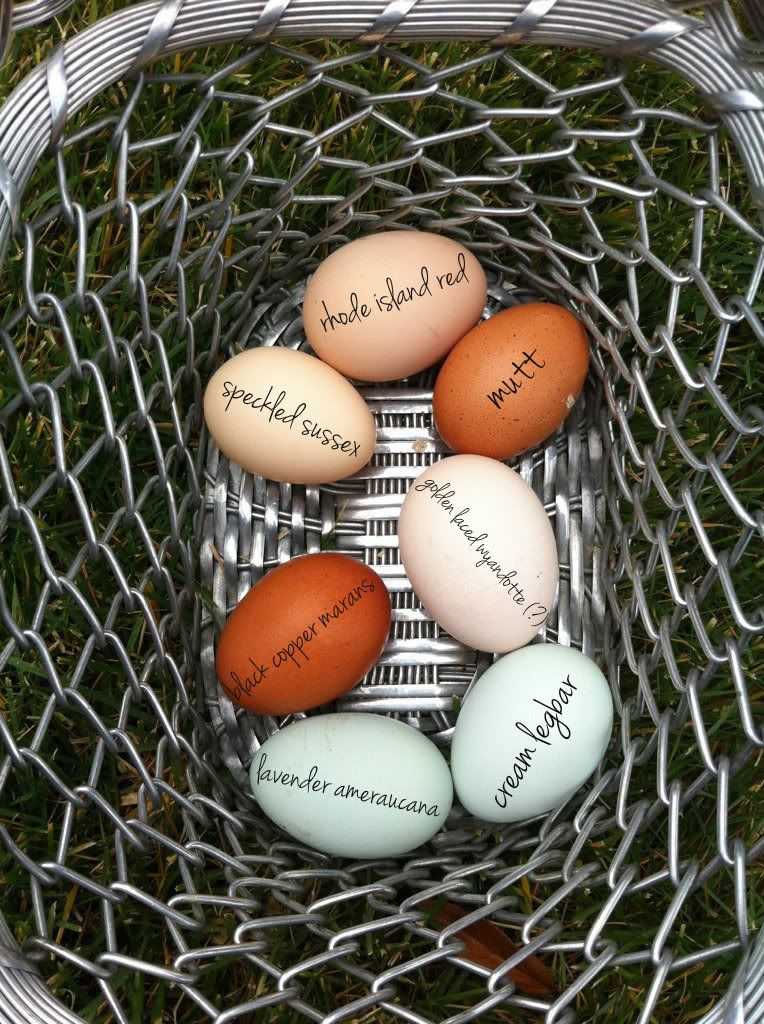

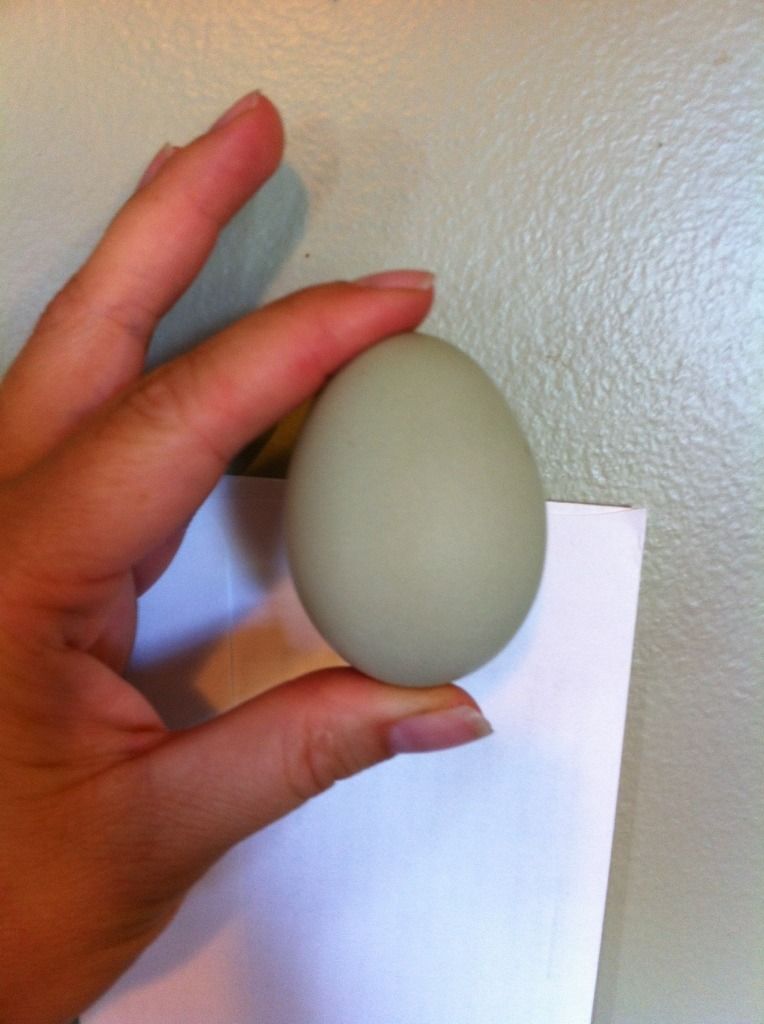
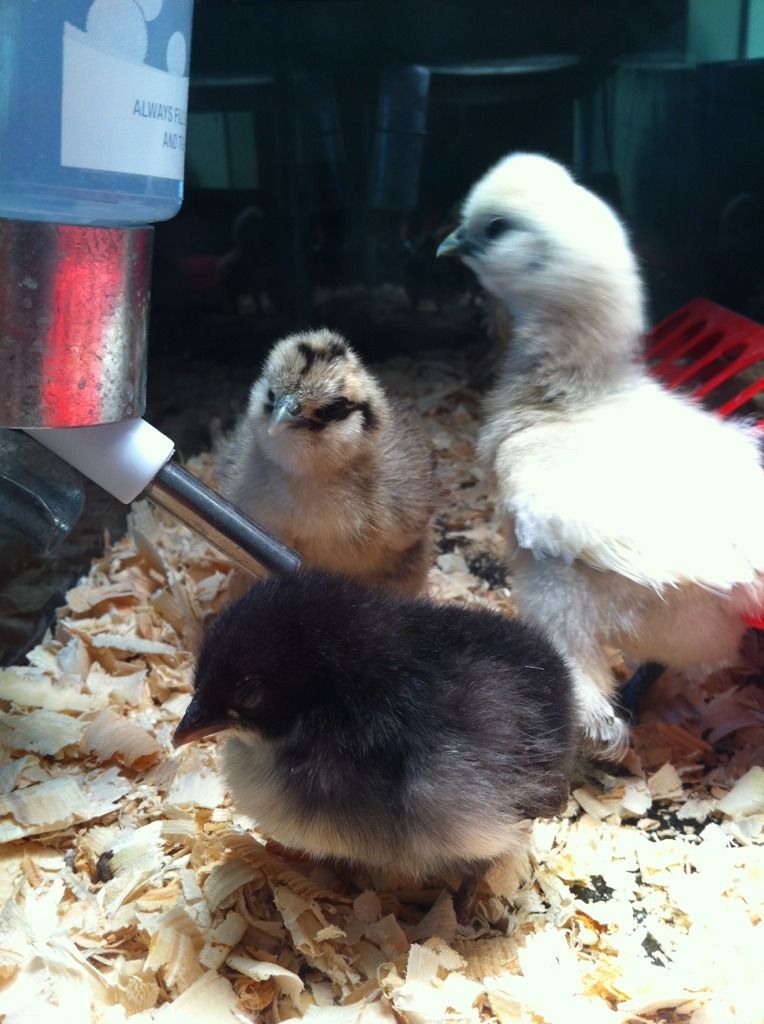
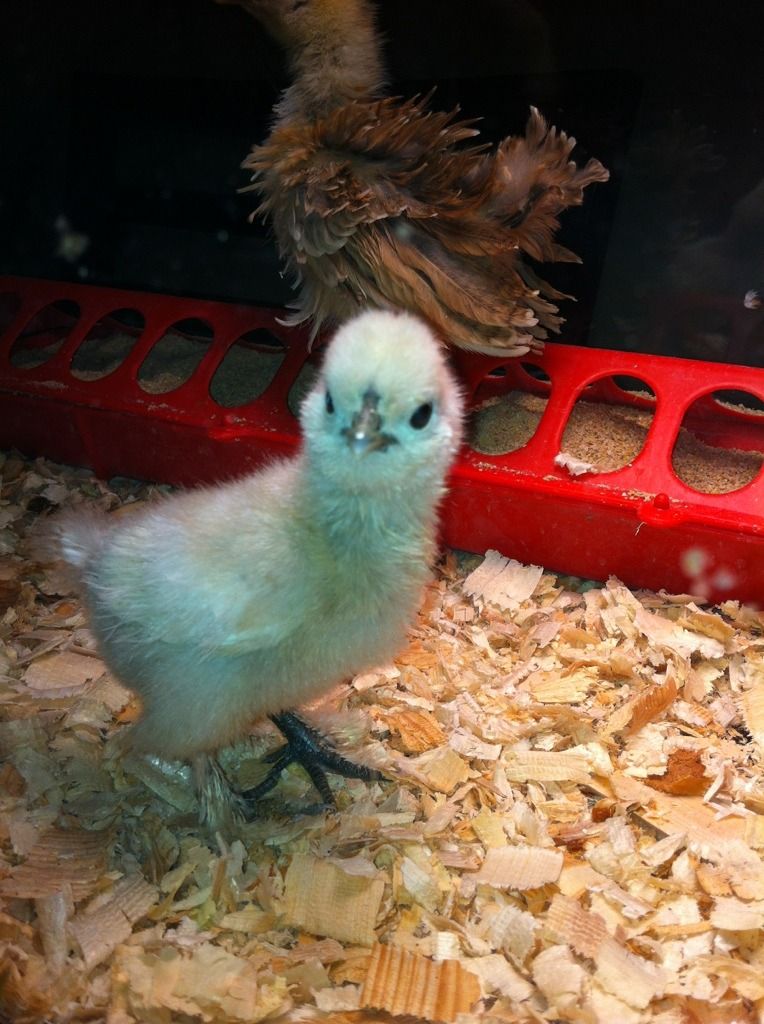
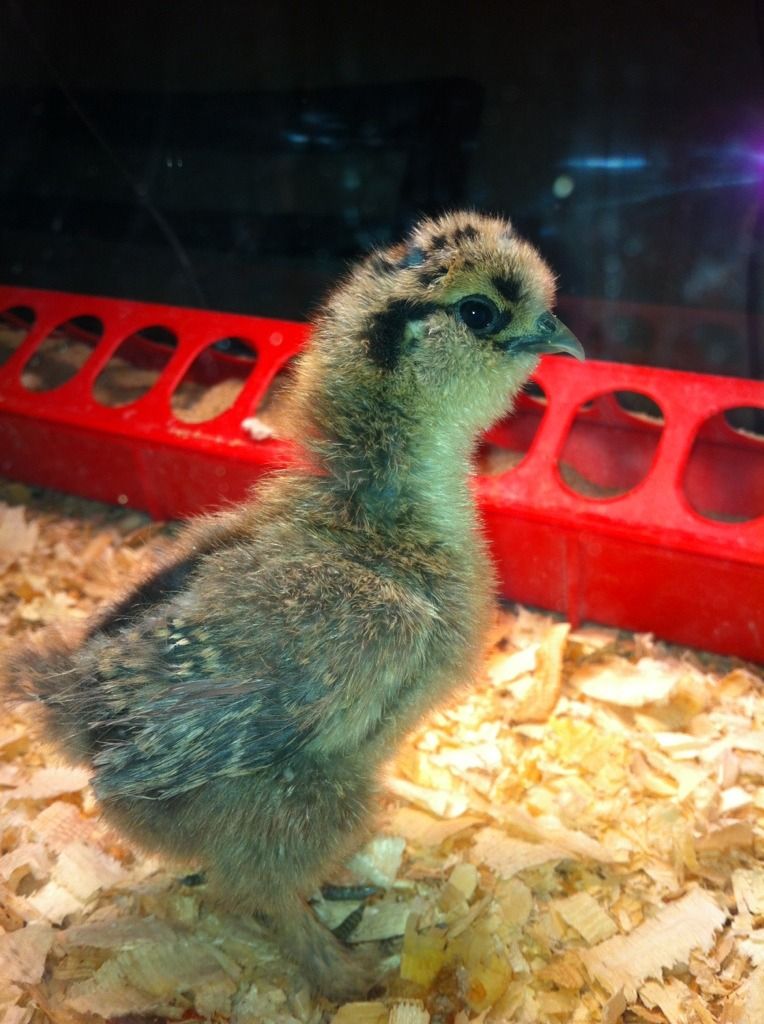
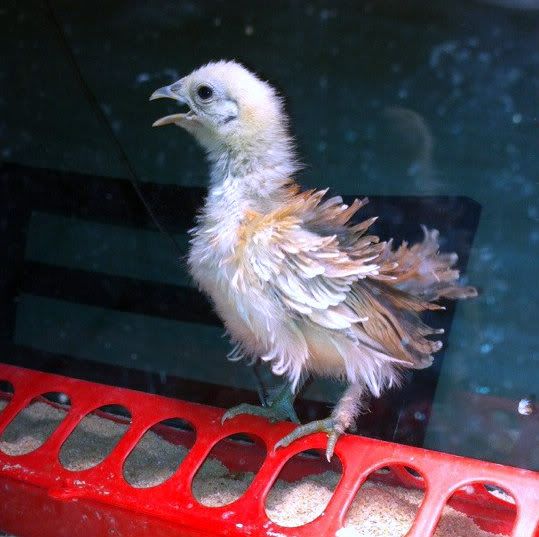
.JPG)
